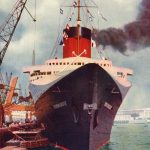Lest We Forget Part 2
The second part of Lest We Forget, the human side of the Lusitania disaster.
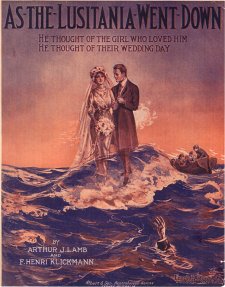
AS THE LUSITANIA WENT DOWN.
The sun was sparkling brightly
upon the ocean foam,
The Lusitania, speeding fast,
was very nearly home.Then came the blow so sudden
that pierced the vessel’s heart.
But while the crowd surged o’er the deck
a young man stood apart.He stepped into a lifeboat,
but ere it left the deck,
he saw a woman and her child
upon the sinking wreck.“Come, take my place”
he told her, and as she stepped inside,
he thought again of those he loved
and like a hero died.He thought of the girl who loved him.
He thought of their wedding day,
as he looked on the angry ocean
eager to seize its prey.He thought of his poor old mother
in a little southern town.
And sadly sighed “thy will be done”
as the Lusitania went down.Arthur J. Lamb and F. Henri Klickmann
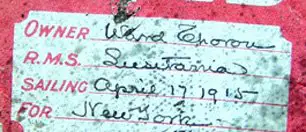
Luggage Label from the Lusitania’s final completed voyage.
Among her passengers were several who would be aboard the May 1 crossing, including W.S. Hodges; Beatrice Witherbee; Charles Tilden Hill and William Pierpoint.
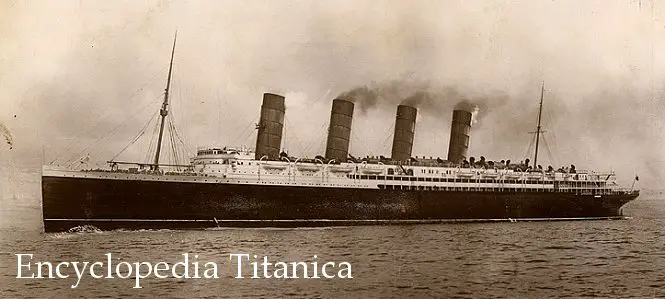
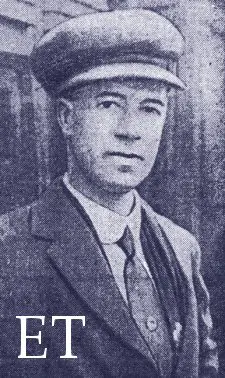 |
| Francis Luker (Daily Sketch) |
The Lusitania was probably not on survivor Francis Luker’s mind on the afternoon of July 17th 1917. Luker, one of the heroes of the disaster, was more concerned with the details of his job as a letter carrier and with the midsummer heat than with his brush with infamy two summers before. He, of course, had no way of knowing that by 5PM he would be dead.
Francis Luker’s 1915 account of the disaster seems full of fanciful details, yet enough of it rings true or corresponds to what is known from other, less flamboyant sources to warrant inclusion:
During the voyage, I picked up with two young fellows with whom I shared a berth and all three traveled together. My two friends went below to get a nap, but I stayed on deck. About 2:30, p.m., as I was standing in the covered alleyway on the third class deck, the periscope of the German submarine was seen about 140 yards ahead…. The noise of the explosion was as loud as a big gun. Smoke and steam came up from the side of the ship in clouds.
The passengers all rushed over to the side of the ship to see what happened, and the lurching of the great wounded liner threw them all in a heap. Another violent lurch of the ship threw hundreds of people into the sea. I held onto a piece of iron fixed to the woodwork on the deck and was thus able to save myself from being away as the people were thrown past me.
I made my way to the second-class cabin to see if I could find a lifebelt, and, passing by the nursery, I noticed a little baby inside which had evidently been left there while the mother went to look for help, intending to come back again and fetch the child. I went forward to get hold of the child, but as I did so, the ship gave another terrific lurch and the door of the nursery was jammed tightly so that I was unable to save the child.
Unable to find a lifebelt, I made my way back to the second-class deck, where the crew were making attempts to launch some of the boats. Owing to the heavy list which the ship had taken this operation was most difficult, and the boats had to be swung so far out in order to avoid the ship, that it was most difficult to get the people into them. The first boat was too full to take me. Another was capsized through the ropes breaking so that the passengers were thrown into the sea. The boat was afterwards righted and the people were got back into it. The list of the ship was so great that I had to take a tremendous jump, which I successfully accomplished. I then grabbed a boat hook and pulled the boat in nearer to the great liner, which more passengers were able to get into it.
It was then that I managed to save Mrs. Wickings-Smith’s baby. She was trying to get into a boat with her baby, but they were holding her back, when I shouted to her to throw the baby to me, which she did. I caught the child, and handed it over to the care of some of the other occupants of the boat. I also caught another child safely, but had no idea whose it was. Mrs. Wickings-Smith was fortunately saved, but I had no idea until two or three hours later.
Before reaching land I changed boats five times, in order to leave more room for wounded passengers and women. One boat that I had got into had a defective plug and it was nearly waist deep in water. The first boat I was in was so close to the ship that they had to hold on to the wireless masts and push the wires away in order to prevent the boat being dragged down by them when the liner sank. She went down with very little suction, but when the boilers exploded, the passengers were smothered in soot and looked like n……s.
After the ship had disappeared, the water all round was just as if it was boiling and everybody thought that their last moments had come. However, we managed to get safely away from the whirling waters and started to render much assistance as we could to other who were still in the water.
Commander Jones was in charge of the boat in which I was finally rescued, and the boat became so full that we to refuse to take any more on board. I was able to render assistance to a lady, Miss Leipold, who escaped from the ship but had both legs injured. She came alongside the boat, and I reached out my hand to her, and for some time towed her along in this manner, afterwards having to grip her by the shoulder when she became exhausted. Eventually, they managed to make room for her in the boat by getting some of the men to lie down in the bottom.
And so things went on in this way until were sighted by a fishing smack and were taken aboard. About 100 from the different boats were got on board this vessel. After we were safely on board we could just discern smoke of the other vessels which were coming to our assistance. We remained on the trawler for about an hour during which time the sailors did everything they possibly could for our comfort, attending to the wounded and giving them whiskey, etc… We were then transferred to the paddle-steamer “Flying Fish” and taken to Queenstown. We arrived at Queenstown about 11:30 pm or nine hours after the Lusitania sank.
Luker returned to Saskatoon by way of NYC, aboard the Orduna in mid September 1915. He resumed his job as a letter carrier, and for the next two years lived quietly. He did not marry, and had no immediate family in Canada. His tragic end was such that decades later it was featured in a New York City newspaper profile. If ever a death can be deemed ironic, Francis Luker’s certainly was:
|
|
Phyllis Wickings-Smith was, by Lusitania standards an exceptionally fortunate woman; both her husband and her daughter, Nancy Eileen, were saved, Nancy being one of only four infants to survive the disaster. The Wickings-Smith party was comprised of Cyril Wickings-Smith, his wife Phyllis, their daughter Nancy and his brother Basil. Basil’s wife Beatrice, who did not sail, was Phyllis Wickings-Smith’s sister. She was not as fortunate as Phyllis, for Basil was lost in the disaster. From the Prichard letter collection (Imperial War Museum) and an account by Gertrude Adams, it is known that Basil Wickings-Smith managed to go below decks for life preservers without being trapped. Phyllis lived less than five years after the Lusitania tragedy, dying January 19, 1920. Cyril, her husband, died just short of the 50th anniversary, on April 3, 1965. Nancy Wickings-Smith Woods, the infant saved by Francis Luker lived until May 1993.
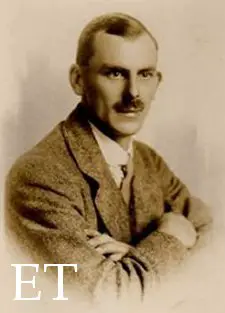
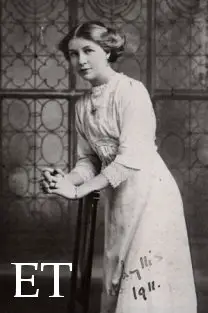
Left: Cyril Wickings-Smith, Right : Phyllis Bailey Fenn
Courtesy of Richard Woods
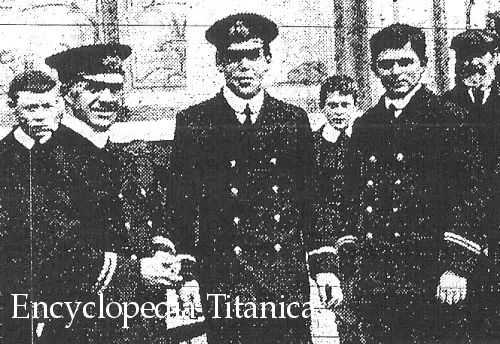 |
| Lusitania Officers Left to right: Arthur Rowland Jones, Albert Bestic, John Idwal Lewis. |
John Idwal Lewis started his sea-faring career in sail. The native of Portmadoc, North Wales was first signed aboard a three-masted bark where he remembered receiving a daily ration of a pound and a pint- eight ounces of butter, marmalade and sugar. He would also add that they gave him a pint of limejuice to ward off scurvy, but he never complained. Since he was slender and only stood about 5’6 in height, it was easy for him to work in tight places. In 1912, he finally went, as he put it, “in steam,” on the Moss Line and the Blue Funnel Line. The following year, he earned his master’s certificate.
He joined Cunard in September 1914 as intermediate third officer and a month later he was assigned to the Lusitania, and he would remain with her until the end.
Recalling his duties, he stated:
“There is a daily inspection on all the ships that I have been in this line, at half past ten. I used to attend on them everyday. I attended the whole of the ship, there was six of us going on this inspection; the staff captain in full charge, the senior surgeon, the assistant surgeon, the purser, the chief steward and myself. It was to begin at half past ten outside the purser’s office on B deck. Then we would start to go all around the passengers’ rooms; we would inspect a room here and there, all the bath rooms, boilers and alleyways, and see that everything was clean and in order, and go right around each deck right down to the saloons and the galleys down to the steerage; the same thing in the crew’s quarters and the firemen’s quarters.”
First Class Dining Saloon“We were all together and met on B deck. We all went together through the B deck section right fore and aft, and down to C deck, and the same thing through C deck, and then we all went down to D deck, and there we divided forces… The staff captain and the assistant surgeon and myself went through the forward end of the ship, through the sailors’ quarters and the third-class and steerage quarters and the stewards’ quarters forward and the store room, and we came along up C deck and went down through the third class entrance and followed the other route through the saloons and kitchens up into the second cabin and met outside the second cabin entrance of C deck, and we went along and went down into the firemen’s’ and trimmers’ quarters which had the entrance on C deck; we went down there. After we finished there, we used to pump back again and go up to A deck in through the verandah café and the smoking room and the house, and were dismissed when we got outside.”
First Class Lounge
The appearance of the ship on the final voyage made a strong impression on John Idwal Lewis. When asked he would say, “A black hull, black funnels.” He was not the only one to describe the ship as having been re-painted from the traditional Cunard colors. Thomas Slidell described the funnels as “giant gray tubes.” Sarah Lund, in her charges against Cunard, claimed that the superstructure was painted gray. Lewis would disagree, while testifying on behalf of the company, and say that superstructure itself was still white.
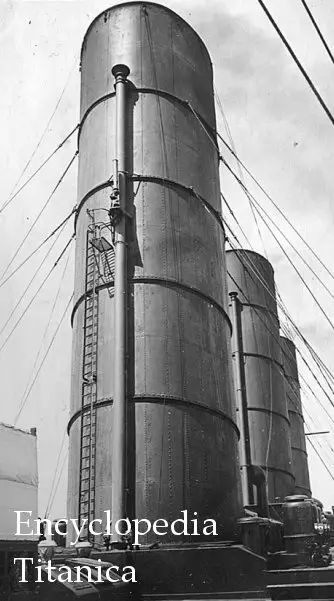
Sailing day was especially busy and Lewis had to make sure several tasks were carried out.
“The morning we left Liverpool we had a Board of Trade mustering drill just before we sailed, under the supervision of the Board of Trade Supervisors; just to muster all hands and all the ship’s members and swing the boats out on both sides, and swing them inboard again.”
He was in charge of the starboard side during the drill, boats 1 to 11, which was next to the quayside, and his boats could not be put in the water. He was not sure if the boats in the port side were rowed in the river. Crewmembers were assigned a certain boat when they signed on, receiving, “a metal badge with the number of a boat on it.” Boat lists were also provided on the ship.
“The names of all the crew put outside their boats. The boat list is a paper and the diagrams for the boats on the port and starboard side with the names of the crew. If I remember rightly, there were three posted aboard the ship. They would be in the living quarters of the different staff for instance where the stewards have their quarters; they would be even down to the glory hole facing them and you cannot mistake them going downstairs.” They were also “in the firemen and sailors quarters… Each officer had a book with the name of the men in his section of the boat, corresponding to the sheets.”
Following the transfer of passengers and crew from the Cameronia, whose voyage was cancelled, the Lusitania was ready to sail. Lewis remembered years later that he looked out and saw a woman running along the dock.
“I saw the gang plank being raised and then lowered again… I happened to be the mail officer on the ship and just when coming on board, after checking the mail, a shout came from the shore, ‘Wait! Wait a minute! Wait a minute!’ And I happened to turn around and saw a lady coming up the gang plank.”
He said that he later learned that it was Alice Middleton.
As the voyage progressed, Lewis may have become familiar with the stories of the crew members with whom he came in contact. Staff Captain Jock Anderson had his nephew George Edward Latham aboard as an electrician. Second purser Percy Draper’s wife was expecting a child, which was due upon his return to England. Albert Bestic, the junior third officer, was to have joined the Leyland Line for his first ship assignment as an officer, but was transferred to the Lusitania. Second officer Percy Hefford, a graduate of the famous Rugby School, had recently gotten married three months earlier. Extra chief officer John Stevens had recently received word, while chief officer of the Cephalonia, that his wife had died. He had to complete another voyage on the ship and then he was allowed to return home- on the Lusitania. Stevens was lost on May 7th, as were Latham, Anderson and Hefford.
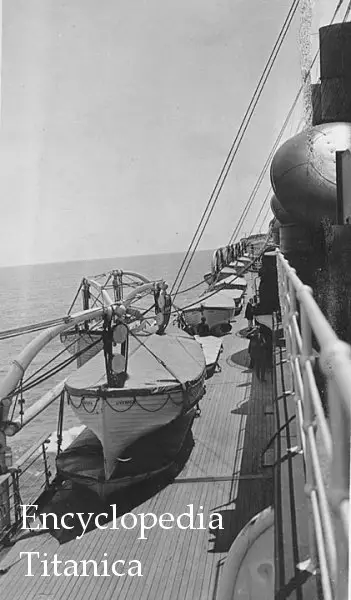
There were daily boat drills, but not for the passengers.
Q Had there been any boat drills during the voyage, prior to May 6th?
A Yes, an emergency drill… Well, we have two special boats in the ship that are always at sea swung out… I think they were 13 and 14; I am not absolutely certain; we used to have special wire guys spread out between the two davits with a life line attached to these reaching down to the water’s edge. Every morning, or usually every morning the whistle would go and these men went back to muster at the emergency boat. Whichever side of the ship was the lee side. There was a picked crew from the watch… Then after these fellows would stand at attention in front of the boats and I would say, “Man the boats,” and these men would get into the boats and put their life belts on and sit in the number of their place in the boat. After I saw that everything was all correct, I would dismiss them from the boats. This was done under my supervision, daily.Q Let us go back a moment, and tell us what the signal for the emergency drill was?
A The steamer’s siren; they used the blow the steam whistle… a long blast and a series of short blasts.Q What did the pursers and stewards have to do at this drill?
A The pursers look after the ship’s papers and the stewards attend to provisions, and so forth, and were attending to blankets and there were the stretcher guard, the ambulance guard.
The lifeboats were readied on the morning of May 6, as the ship approached the war zone.
Q When the boats hang in the davits with these short chains on them how high up are they above the deck?
A Well, they should be–the boat should be about 8 feet from the deck.Q Could anybody get into them at all?
A Well, I suppose I could if I jumped.Q And when the boats were swung out the morning of May 6th, you say they were lowered down to be on a level with the collapsible boats?
A Yes.Q How high would that bring them down above the deck?
A The collapsible boats would be about 3 feet–about five feet; you have to go over the collapsible boat to get into the lifeboat. The lifeboat was not lowered to the level of the deck, but to the collapsible boat; just a matter of 2 feet.Q Could the lifeboat be lowered after that was swing out, to be level with the collapsible boats, with out disengaging these chains to which they were hung in the rocker?
A Impossible.Q Won’t you describe the collapsible boats?
A A collapsible boat is something similar to a life raft, rather flat bottomed, it only raises about 18 inches from the deck… just like an ordinary (boat)–two bows on it and wider in the beam and flat bottoms. The wooden part of the boat is only about 18 inches deep… Decked over, watertight tanks, inside. Above that there is canvas sides that you raise up, like opening a concertina, fixed up with iron bars to raise the seats up.
He stated, “All the ports were to be closed and not only that, all the windows at night were to be closed and darkened and all the doors leading to the decks were to be closed at night.”
Lewis was careful with his wording while testifying, lest he be contradicted by other witnesses:
Q Were any ports open, so far as you know?
A No, not as far as I am aware of it, no.Q On the day of the accident?
A As far as I am aware of it, no.Q Of course, you were not in any passenger’s staterooms to notice the ports?
A No.Q But the ports in the alleyways and in the places you were in were in what condition?
A They were closed, all those ports; one or two of these might be open on C deck. They open on to the shelter deck; there were men detailed every morning to clean the brass work on those ports, because they open on to the third class passengers’ promenade deck and there are two men specially detailed off to clean the brass, and probably they were cleaning them at the time, and there might have been one or two open, but if any water came in there it would go down the wooden deck and would run out through the scuppers.Q Did you attend on the night inspection of May 6th?
A Yes, I didQ At what time?
A From about half-past eight until 10 o’clockQ What was the condition of the ports that night?
A They were closed as far as I could see; some places of course I couldn’t go.Q To what do you refer?
A I refer to some of the staterooms of the passengers.Q Had there been orders to have all ports darkened?
A Oh, yesQ Were you running without lights?
A We were.
Lewis had an unenviable shift the day of the sinking. “I was on from 4 to 8 in the morning… on the bridge… with the chief officer… I remember that when I went on watch in the morning that I had my overcoat on and was glad of it too. Yes it was foggy.”
He had a quick breakfast, and from there was off to the baggage room.
Q Where was the baggage room, by the way?
A It was down – the entrance is on C deck, it is right in the bottom of the ship.Q Were you down there continuously, or were you up and down?
A I was going up and down.Q Were you on deck at all?
A I was out on deck, on C deck.Q On the side, so you could see the condition of the weather?
A Oh, yes, you could see all around… It was, as far as I can recall it, foggy all morning.Q What was the conditions of things then, as far as being able to sight the land was concerned?
A Well, the weather was clear, but hazy over the land… I could see land all right, but I didn’t take too many particular notice what it was; I knew were we out to be, so I guessed where we were.
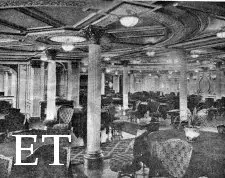 |
| Dining Room |
He finished his duties about quarter of one, and proceeded to his cabin to change for lunch. He was going to join first officer Arthur Rowland Jones in the first class dining room. His table was “on the port side… the after table of all on the portside… It was right from the side of the ship, right to the door of the grill room, to the entrance of the grill room, a square table.”
Q Did you notice anything about the ports in the dining room while you were having your lunch?
A No, they were shut on my side, as far as I could see.
Several passengers in the dining room contradicted Lewis.
James Brooks: On my left, I sat facing the bow and very near the entrance on the left of that section of the dining room that was all open. That would be just the same as these windows are here, and I sat on the port side of the center line at the dining table; they were open on that side.
Rita Jolivet: They were open.
Frederic Gauntlett: Nearly all were open… Well, I left my coffee and nuts and rose from the table and shouted to the stewards to close the ports.
Oscar Grab: I noticed that they were open.
Charles Lauriat: Yes, because there was an electric fan right over my head, and with the portholes open, the draft and the fans going at the same time made it very drafty.
Isaac Lehmann: It was a beautiful day and all the portholes were open.
The band was playing ‘Tipperary’ and Lewis was “just about finishing” his lunch when there was an explosion. “I should say it was just like a report of a heavy gun about two or three miles away from us.”
Q From what point on the ship did it appear to come?
A From the fore part of me on the starboard side.
Then he heard something else.
“A few seconds afterwards, whether it was an explosion or not I couldn’t say, but there was a heavy report and a rumbling noise like a clap of thunder… It was accompanied by the sound of broken glass, like glass breaking. That was on the starboard side again, forward of me, but closer than the first one was, further aft that the first one. I stood up and looked around and both of us walked out of the saloon. Of course, we couldn’t run out, there were too many people ahead of us.”
The ship began listing immediately.
“I should think it would be about 10 degrees when I was on the staircase. I went up along the main saloon staircase up to C deck. The only difficulty was that the place was crowded with people ahead of me. I came out on to the C deck on the port side and went up on the boat deck along the outside ladders, the outside staircases.”
One of the first people he saw was Mr. Piper, the chief officer, “standing by No. 2 boat.”
Q Had the ship begun to swing over toward the land yet?
A She must have, because when I went over on to my own station I could see the land.
Going to the bridge he found the quartermaster. “I sang out to the quartermaster and I said, ‘What is the list on the telltale, on the compass,’ and he told me 15 degrees.” He had no lifebelt. Percy Hefford, the second officer, had thrown him several from the bridge, but he gave them to other people.
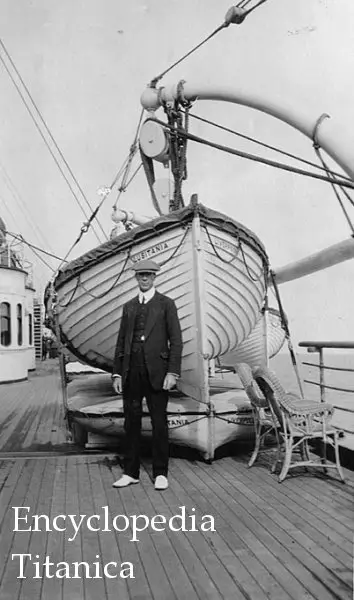
He went to his own station, boats 1-11 and found Mr. Jones on the starboard side as well. One of the first things he noticed was that lifeboat 1 “was lowered into the water before I got up there, but the tackles were fast to it, the after fall was a bit tighter than the other one, so the boat was heading out to sea and had been drawn sideways along the ship, but it was floating in the water.” There were two sailors in it.
He did his best to fill the boats in his section, but almost none got away.
“Well, filled them up with passengers, with people; I don’t know whether they were passengers – I filled it up and lowered it down… The list of the ship would swing the boat out from the edge of the ship… When we had taken the women passengers on to the edge of the collapsible boat to get into it the distance was such that they rather drew back instead of getting in it; we had to use our best judgment to try and get them into the boat. Some were afraid of attempting to go across.”
Q How many people do you think were in?
A Well, it was loaded, as far as I could see, full; of course, I didn’t stop to count them; I ordered them to lower away and it was lowered away… I saw it unhooked and settle in the water.“When I was standing on the deck I saw a fishing schooner way over inside, and was looking at that and wishing it was a bit nearer, and I could swim for her, but I could see the land too and was wondering how I could make it.”
Not everyone was cooperative:
“When I was getting one boat out, I forget the number, I was standing on top of the collapsible boat seeing it lowered down and it was full up and these fellows when they saw the boat being lowered tried to rush it. Of course, I had to stop them.”
He made his way down the deck to work on the forward boats, and was opposite the first class entrance.
“I filled that boat; I saw that they started with the filling that boat, because when they were getting well under way there, I went further aft again and saw Mr. Jones and I said, ‘I had better give you a hand there, because they are filling mine up here,’ and that was one of the boats that he and I lowered. He took charge of one and I took charge of the other end, so that there people were lowered down properly.”
Following that, he claimed that he went back to his own section.
“I was continuously between no 1. and no 9. after that, going from one to the other, seeing that they were going all right.”
Q Did you get 9 down safely?
A It was lowered into the water safely.Q And unhooked?
A And unhooked.Q And away?
A Well, whether it drew away from the ship’s side, that was something I don’t know. I didn’t see it exactly going out, but I saw it in the water. I simply gave orders and said, “All right” and when the boat was in the water I said, “Get out with her.” A lady passenger was in the boat there, and I was standing on the deck and the boat was just away from the ship’s side and screwed up, and she stood up and sang out, “For God’s sake jump.” I looked at her and said, “Good-bye and Good luck. I will meet you in Queenstown.”
Working back and forth, the last boat he went to was 3. He said there were very few people left on the deck.
Q Were they able to stand up?
A No, not without hanging on to a bit of the hand rail on top of one of the houses; in fact, it took all I could to stand on the deck.
Looking about he saw, “the water was on the bridge deck and rising fast; I made an attempt to go aft and missed my footing, but I got hold of a collapsible boat… I was standing up to me knees in water, practically.”
To his surprise, he spotted a tiny gold watch, no bigger than the size of a quarter being swept along the deck by the water. He reached down and pocketed it.
“I fell in the water on the deck and got hold of the collapsible boat and scrambled on it and got hold of the rail on the funnel deck or hurricane deck, and got over there and tried to make my way across to the port side to take a dive off, but I was just about half way across when she went down under me.”
Q When the ship went down were you drawn under?
A I must have been, because I didn’t see anything of the ship and I was in the fore end of her; when I came up to the surface there was no sign of the ship at all.
When he rose to the surfaced, he grasped a piece of a boat chock. “Sometimes I was on top and sometimes I was underneath it, and eventually I got alongside of a collapsible boat that was just floating stem up, about one-third of the boat sticking out of the water, and I got on top of that and was there half an hour when a trawler picked me up.”
He landed in Queenstown, and left the next afternoon for England. He rose, during the war, to the position of chief officer; one of his ships being the Carpathia. He gave several sets of testimony during the Liability hearings.
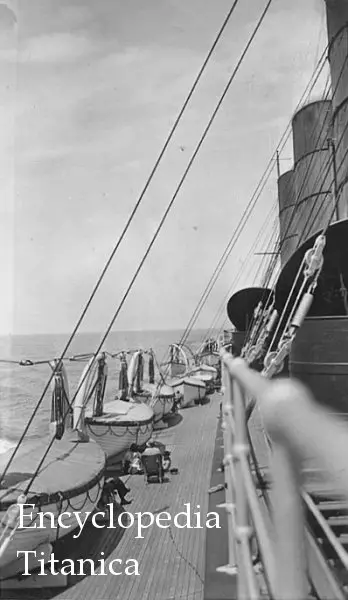
The fact that so few of the boats got away did not escape the lawyers.
Q I notice in the book that Mr. Lauriat wrote, I believe it was written while he was there in Great Britain after the disaster, he says (page 49): He speaks of seeing in the slip six lifeboats, inside the wharf at Queenstown. He mentions the numbers 1, 11, 13, 15, 19, and 21; did you notice at any time notice the numbers of the boats after you got to Queenstown, the ones that were brought in?
A I never saw them in Queenstown.Q Do you, yourself, know how many lifeboats you actually got away from the ship with passengers?
A No.
John Idwal Lewis attained the rank of Captain, and then was made the assistant marine superintendent of the Cunard White Star Line. He married a woman named Sophia and had two children, Henry and Joan. He made his home in New York and also vacationed in Inverness, Florida. He was a member of the Pyramic Lodge, number 490, of New York City. When he came across a newspaper interview fellow officer Albert Bestic conducted with Captain Turner, he was miffed that Bestic assumed he was dead.
Bestic wrote, “I am the only surviving deck officer of the Lusitania and with the anniversary of the great liner’s loss arriving, it occurred to me to go to Liverpool to see my old commander and find out how he was faring.”
Captain Turner was described as “alert” and made several interesting statements. Bestic asked Turner if he thought the ship would be torpedoed.
“Yes, I was distinctly worried. I was advised by the Admiralty that I was to keep a mid-channel course. As you remember, we were warned by wireless that there were six submarines waiting for us in mid-channel. That was the chief reason I closed in on the coast. I thought that if the ship were sunk near shore, the top deck might be above water, allowing the passengers to escape… I am certain she was struck twice.”
The former officer, turned writer, then asked about the rumor of gold aboard. Turner replied, “No gold of course, but there must be a lot of money and jewelry in the purser’s safes. I am quite sure of that.”
He chuckled about his own property left aboard the ship. “There are 15 (British pounds) that belong to me. That is all. But there is an old sextant I value. It’s in the left hand drawer of my desk on that ship.”
Lewis’s rebuttal came a few days later.
“I was third officer of that ship and standing by my station amidships, when she heeled to starboard and went down bow first. We managed to launch 6 lifeboats in which 700 person were saved… Three deck officers were saved besides Captain Turner. A.R. Jones, the first officer who was drowned later in the war, and Bestic, a young Irishman from Dublin, who was making his first trip in the Cunard Line- I think it was his last, because I never heard of him afterward. He was the junior third officer.”
On the 20th anniversary of the disaster, he had a reunion with several crewmembers who survived the sinking. It was held in his office at the New York Cunard White Star building. He met with, Richard Wylie, assistant marine engineer of the line, and William Ewart Gladstone Jones, chief electrical engineer of the Scythia. Later they were joined by Alexander Duncan, who was the chief officer of the Berengaria, and Charles Dunn, chief engineer of the Bantria. They planned on drinking a silent toast to all their shipmates who went down with the Lusitania.
He retired in 1950 and moved to California in 1956, as both of his children lived there. He settled in Stockton in 1960. The “short, taciturn” sailor spent his time sketching ships and working in his garden. Towards the end of his life, he suffered from illness and in his last year, resided at the Lodi Convalescent Home. Lewis, the last surviving officer, from the Lusitania’s final voyage, died on October 21, 1974.
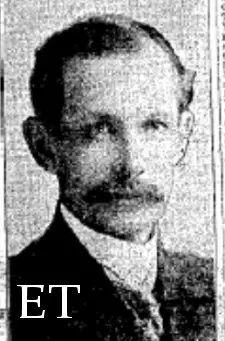 |
| Alfred Russell Clarke |
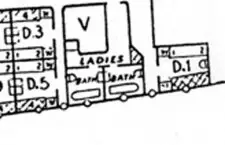 |
| Clarke’s Cabin (Paul Latimer) |
“This looks like a fine boat and I cannot help feeling proud that the British flag rules the British waves, and I have no fear of the German submarines. There is quite a crowd on this boat and apparently they are not afraid.”
Alfred Russell Clarke, a first class passenger, penned this note to his son Griffith before the Lusitania sailed. He did not have time to be afraid of submarines; he was busy with plans to expand his business by securing leather contracts with British Army. Clarke was an ambitious man. Born in Peterborough, he moved to Toronto at age 18 and founded A.R. Clarke & Company, Limited, which eventually became the foremost producer of patent leather in the British Empire. His factory employed over 350 people who produced leather linings, leather vests, moccasins, and other articles of clothing in which leather was used. He was married to Mary Louisa, and had a son, Griffith, and a daughter, Vivien. He belonged to many organizations including the Riverdale Business Men’s Association; Toronto Housing Co.; Toronto Civic Guild; Canadian Manufacturers’ Association, Ontario Motor League; and Masonic Order. He was also the treasurer of the Metropolitan Methodist Church.
On May 7, Clarke was comfortably settled in a chair on the top deck when, “there came the sound of a loud explosion. Fragments and splinters flew all around and a great torrent of water was forced up by the explosion and poured over the deck. The ship instantly took a severe list… The stairway was already crowded with people trying to get life preservers… I started to go to my cabin, but found it difficult owing to the angle and I returned to the upper deck.”
He stood at the back of the crowd, adhering to the rule ‘women and children first’, and did not push his way forward. Talking with others, he heard that the Captain had ordered that boats not be lowered.
“As the list grew greater, I again tried to reach my cabin for a lifebelt. The cabin was utterly dark. I felt to remain there I would be caught like a rat in a trap. The cabin door closed as I entered… I was distressed to find the door jammed… I could not open it owing to the acute angle of the ship, but got out through a side door, and mounted the deck again.”
Author’s Note – He had a small inside cabin, D-3, which on the original deck plan for the Lusitania appears not to have a connecting door. However, one may have been added later, or more likely he may have upgraded while onboard to a cabin that did.
He encountered a young man who had sat his table in the dining room. He was tying on a lifejacket and asked Clarke if he wanted one.
I took it and as it was impossible to stand upright, I suggested to my companion that we should take no more chances, (and) to try for a boat… He said: ‘Oh no,’ and that was the last I saw of him…Glancing over I saw two boats being lowered jambed (sic) together and trying to get free. The other boat was trying to shove off from us. The four great funnels were now hanging at such an angle as though they would soon touch the sea. Then I was torn down in the whirlpool. I seemed to touch the very bottom of the ocean.”
Clarke felt something gripping his chest, “crushing me. Something else seemed to wrench me around. I was twisted and racked. All this time I was fully conscious. I remember hoping this would soon come to an end. Suddenly, what was holding me let go, and I rose rapidly to the surface.”
The next thing he recalled was floating near a boat and two sailors pulling him aboard. The only person he recognized was fellow Canadian, Leonard McMurray.
The sea was full of people. There were perhaps five or six boats around. Bodies floated by us. The corpse of a baby clung to the bottom of our boat. We could not reach it. A woman floated by, foam coming from her mouth. I put out my hand, but as I touched her hair, she passed away.”
They drifted about for three hours until they were rescued. He did not remain in Queenstown long before making the trip to London. Once settled in the Hotel Cecil he called for doctors to attend to his injuries. It was discovered that he had a broken rib and was taken to the Fitzroy House Hospital. His temperature rose to 102 and the doctors found that the broken rib had affected a lung and pleurisy had developed. His wife was sent for at once, and Mary Louisa sailed for England and arrived in London on June 12. Meanwhile, pneumonia had also set in. At first, Mrs. Clarke had high hopes for her husband and sent telegrams home saying that his improvement was “more than maintained” and that great hopes were entertained for his recovery. Griffith Clarke had intended to also come, but his mother told him it was not necessary. But then Alfred took a turn for the worse. His family received two telegrams.
“Your father very weak. Mother very discouraged. Time very short. Advise you not to come.”
Shortly thereafter, another telegram arrived.
“Mr. Clarke is sinking rapidly. We are with your mother and will give her every attention.”
Alfred Russell Clarke died on June 20. A family friend cabled Griffith and Vivien
“Your father passed peacefully at 9:20 tonight. We will take care of your mother and arrange everything for her, including her passage and your father’s home. Cable me any instructions.”
Mrs. Clarke came home on the Lapland and proceeded to Toronto with the body of her husband. Following the funeral it was determined that he left an estate of $521,825.28, part of which was comprised of $34,845 in life insurance and $50,000 in accident. His real estate holdings were valued at $41,140 and the fair market value of the stock in A.R. Clarke and Company, Limited was shown to be $393.000. Griffith Clarke was appointed managing director of the company and following his death in 1923, it was alleged by his mother, in her case against Germany, that he ran the company into the ground and that had his father survived, the business would have prospered. How true this is, cannot be said. What is known is that Mrs. Clarke herself had an active interest in the company and when her son died, she took full charge. Mary Louisa filed a claim against the German government that totaled $125,000. At the time of the claim hearing in 1925, she was drawing a salary of $24,000 a year from the company. Commissioner James Friel was not sympathetic to the various claims and awarded the widow $7,500, which he deemed ‘fair compensation.’ He stated that
“the insurance money alone at her age would have purchased for her an annuity of over $6000 a year. I do not think it can be said she suffered any pecuniary loss resulting from the death of her husband.”
Mrs. Jane MacFarquhar, a woman of about 53 years in 1915, was traveling to Scotland to settle some family financial matters when she survived the Lusitania disaster. Some years previously, Jane had inherited her father’s estate in Burghead. Mr. Grant’s will allowed his wife, Jane’s stepmother, the right to use the estate he had left to Jane while she, Mrs. Grant, lived. Mrs. MacFarquhar had learned that the 83 year old woman was seriously- and likely terminally- ill, and, in seeming anticipation of her death, was traveling to the paternal home to oversee the eventual disposal of the property. Her youngest daughter, Grace, 16, accompanied her. The MacFarquhars booked second class passage on April 27th 1915, and planned for a long stay, of undetermined time, in Europe.
Like so many other survivors, Jane later described the voyage as being an extremely pleasant one. And, like so many other passengers, Jane would relate that there was a sense of unease as the ship entered the war zone:
Jane and Grace spent their final mid-day aboard the Lusitania preparing for disembarkation the following morning. They carefully laid out changes of clothing for themselves, before attending luncheon in the Second Class Dining Saloon.
The MacFarquhar’s boat was eventually picked up by a British patrol boat, and they were landed at Queenstown around 9PM. Jane and Grace remained in Scotland for more than three years before returning to Mr. MacFarquhar, and their home in Stratford Connecticut, at the war’s end. Life was at first comfortable for the family. Grace studied nursing in New York, and graduated as a registered nurse from Metropolitan Hospital in 1924. A biographical sketch of the MacFarquhars published in the 1930s claimed that an unnamed “nervous condition” Grace and her mother blamed on the Lusitania experience deferred her nursing career. After John MacFarquhar’s death in an explosion at Christmas 1926, Jane and Grace’s fortunes allegedly declined precipitously. By the mid 1930s they were living in a small but comfortable duplex at 199-201 Hollister Street in Stratford. One of Grace’s arms was partially paralyzed and Jane, in her 70s, was supporting the two of them by tilling her small vegetable garden at the home she “owned clear.” They were the subject of a newspaper profile on the anniversary of the disaster, which may have exaggerated their penury for ‘human interest’ but which contains their last known – and bitter – public statements about the disaster. Jane died, at age 79, on April 21, 1942 and was buried beside Mr. MacFarquhar at Stratford’s Union Cemetery. After Jane’s death, Grace may have returned to nursing. Details are sketchy, but a letter written by her brother, Colin, in the early 1970s reveals that by then she was under the care of her niece, Mrs. Jane Peck, of Bristol Connecticut. She died in New Britain, Connecticut on February 9, 1979, at age 80, and was returned to Stratford for burial beside her parents. The MacFarquhars share a single stone and are the easiest grave in the cemetery to locate- they are literally the first grave on the left as one passes through the entrance. |
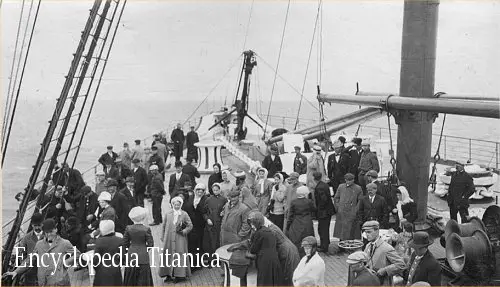
Well Deck
Mrs. James Logan was returning, along with her two and a half year old son, Robert, to Ayr, Scotland, for the duration of the war. Her husband had enlisted early on, had been wounded in Ypres in November 1914, and by May 1915 was once again at the front. Mrs. Logan was leaving their residence of one year in Paterson, New Jersey, for the security of her girlhood home. Mother and son traveled in third class, and Ruth Logan survived the disaster. Her account remains among the best of the few left by third class passengers: it begins on a staircase where, at the moment of the torpedoing, the young mother was making her way to the open deck with her child walking ahead of her so that if he missed a step he would not fall far.
I never let him out of my sight, as I was afraid something might happen to him. There were people coming behind me, and when the shock came we were all jolted about. I immediately seized Robert and ran on deck. The vessel had a considerable list to one side, but she righted herself for a few minutes and several men clapped their hands and tried to reassure us that she would keep afloat.
The day before the disaster there were sports on board and as Robert was too wee to take part in the general amusement, I took to running after him crying as I did so “I’ll catch you!” And, oh! The tragedy of it all. When the rush for lifebelts came Robert could not understand it all and lisped the words I had used the day before.
Everybody seemed to be running around, and everybody seemed to be getting lifebelts. I appealed to several, but no one in the excitement heeded me until a sailor came along. I took him to be an officer. “Wait a second and I’ll get you one” he said, and he immediately reappeared with a life jacket and he put it around me. I said to him “What about the child?” and he replied “Put him in along with you” and he lifted my child and put him inside the jacket which was around me.
He immediately began to struggle, and wanted down on the deck, and another sailor passing me a minute later advised me to put him down till he could get the jacket put on right. I asked him to get a lifebelt for the wee chap, and he hurried forward to get one, and at that moment the ship went over. I held onto his hood and we went down together, and I still had a grip of him when we came to the surface, but the child’s struggles and the struggling of hundreds of others in the water around me caused us to be separated.
Mrs. Logan was in the water for nearly five hours before she was picked up, unconscious, by a torpedo boat, around 7PM, and was still unconscious when she was brought ashore later that night. She awakened in Haulbowline, where, at first, she assumed that her memories of the tragedy were of a horrible dream. Before traveling on to Scotland, she was able to identify her son’s body in Queenstown. Robert Logan, body #42, was buried in common grave C in Old Church Cemetery.
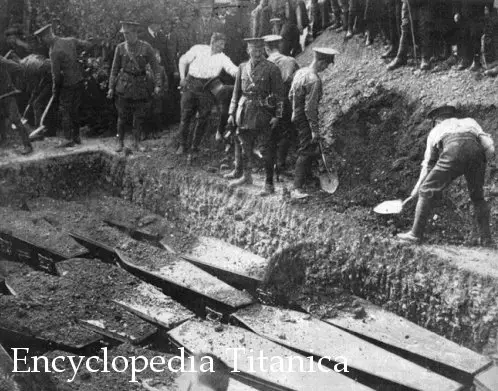
Common Graves
Mrs. Logan’s husband, Corporal James Logan of the Gordon Highlanders, survived the war, and they returned to New Jersey together. Several more children were born to them, including a second son named Robert but their life together was not to be a long one: the 1930 census lists James Logan as being a widower.
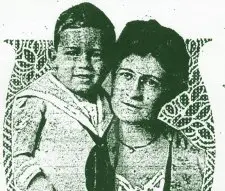 |
| Terence Florence Gray and her son, Stuart (Paul Latimer) |
Terence Florence Gray, of California, boarded the Lusitania with her son Stuart, 3, and father- in- law James Paul Gray. His wife, Carrie, was abroad, visiting the ancestral home in Scotland, and the three were to join her for an extended vacation.
James Paul Gray survived, injured, by clinging to an overturned lifeboat, but his daughter in law and grandson were lost without a trace. He was later to learn the details of their final moments aboard the ship, which perhaps gave some small comfort to him, his wife, and his son William Hiram who was Terence’s widower: Mrs. Gray and her child at least had gotten clear of the Lusitania and were not trapped below decks when it foundered.
Terence, known informally as Florence, had just put Stuart to sleep in a deck chair when the torpedo struck. She was together for much of the duration of the sinking with her shipboard friend, Maud Turpin. Presumably they searched for their missing relatives as long as time permitted, but what is known for certain is that at the end the two women stood with Stuart Gray and Thomas Turpin on one of the upper decks and stepped into the sea together as it washed towards them. Only and Mr. and Mrs. Turpin survived; she was reunited with her husband in Queenstown and later gave an account to the Gray family. Mr. Turpin later gave an account in which he said found his wife aboard the Lusitania, before she sank. He did not mention seeing Florence or Stuart Gray being with his wife, but did say that after the ship foundered, he was able to climb atop the same capsized lifeboat as Mr. Gray.
This indicates that at the end, Florence and her son were very close to their missing relative.
James Paul Gray never fully recovered from the injuries he sustained in the sinking, dying in September 1922. His widow was awarded a settlement of $10,000.00 by the Mixed Claims Commission. William Hiram Gray received $25,000.00 for the loss of his wife and son in January 1925.
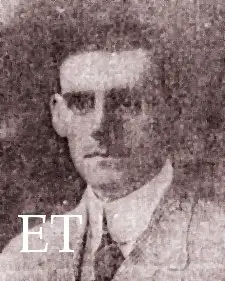 |
| Edward Harris Lander (Michael Poirier) |
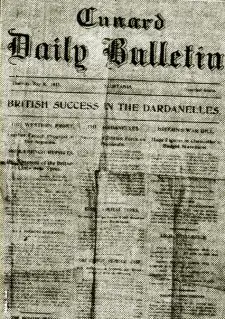 |
| Cunard Daily Bulletin May 6 1915 |
A happier ending lay in store for Mrs. Sarah Fish, who was part of an extended family party traveling aboard the Lusitania. All but one surmounted the odds by sinking with the ship and surviving. The lost child-her youngest- spent the last minutes of her life with a heroic man who did his best to save her.
Edward Harris Lander was born on November 23, 1882 in Glen Ochil, Scotland to an Irish father and an English mother. The family settled in Bristol, England in 1901, from where Robert emigrated to the Untied States ca 1907. He met and married a woman named Christine in Chicago; they had one son, Robert. They lived in New York where he worked as the U.S. representative of a London firm. His trip on the Lusitania’s final voyage combined business and pleasure for he planned to visit his family in Bishopston, Bristol.
On the voyage he made the acquaintance of Elizabeth Rogers and her sister Sarah Fish. Mrs. Fish was bringing her three daughters back to England for the duration of the war while her husband Joseph served in the Canadian Expeditionary Force. They were, in descending order: Eileen, age 10, Marion, age 8, and Joan, about 6 months. Mrs. Fish recalled that there was much banter regarding the German warnings, for no one she met took them seriously.
On the day of the sinking, Edward Lander and Elizabeth Rogers finished their lunch and went for a walk on deck with baby Joan. Meanwhile, Sarah Fish continued to dine with her middle child Marion while Eileen played on deck Lander was standing by the rail with his friend when someone turned his attention to the wake of the torpedo.
“The missile headed straight for the Lusitania, and hit her about mid ship. Someone cried out, ‘It’s got us,’ and upon contact with the vessel, the torpedo exploded with a dull sound, not making a big racket. We saw a big cloud of smoke; the engines of the Lusitania stopped, and the vessel took a list to starboard.
Authors note: Although Lander said the ship listed to starboard, he claimed that he saw a torpedo strike from the port side.
We crawled onto the first cabin deck and with many others with us, and soon there was lot of water on part of the deck. I gripped the baby and held the young lady by the wrist, and we managed to scramble to the deck where the boats were. That deck seemed pretty clear. The lady and I found a lifeboat, into which we got, and I kept the baby in my arms. The boat was crowded with members of the crew, so there was not much room to turn round in her. Then somebody came alongside and said, ‘It is all right. She’s on the bottom.’ Thinking it safe to return to the ship, we all got off our boat and again went aboard the Lusitania. Doubt arose to the safety of the ship and people began to get into the boat again. Suddenly, the Lusitaniasank. Our boat was attached to her by a rope, and we went down with the steamship. The baby was wrenched out of my arms and it seemed, in going down into the sea, as if I turned over and over again. Then I felt myself coming up again. I came to the surface, but sank once more. Coming up a second time, I struck out a little and saw an over turned lifeboat a little way off. One man was on it. I reached hr, and getting on her, lay for a little while. I was very nearly unconscious. When I recovered somewhat we saw a woman’s dress in the sea- merely the back of the garment was showing. The man in the boat got hold of the woman’s head and I held on to her clothes, and we pulled her on to the flat bottom of the overturned lifeboat with us.”
“Soon after, we saw a collapsible lifeboat, with six men on her – members of the crew, I believe. Her side was stove in, but she kept afloat. We hailed her; she came to us and they took us aboard. I was shivering greatly, and one fellow who seemed in command, told us to take an oar. The pulling worked up a little circulation and made one feel better. Then, someone else took a turn at pulling and I was put back on the bottom of the upturned lifeboat again. There were many people floating around, and we saw two men and a woman hanging on to a tank boat. Those were afterwards rescued by the collapsible boat. The lifeboat on which I was allowed to drift for a time and for a time was secured to the collapsible by a rope. Boats dotted the sea, and hope was raised by a little fishing smack that could be seen off the Irish coast. There was not much wind, however, and the smack went towards the coast instead of coming to us. Possibly she had as many people aboard as she could take. There were lots of deck chairs floating around, but we saw only one that as being used as means of support and that by a woman who also had a lifebelt. Then we arranged to cry ‘Help’ in chorus. H.M.S. Bluebell, a government tug or patrol boat, came to our assistance…”
The Fish family had a horrific experience as the Lusitania went down. After the first explosion, Eileen made at once for the second-class companionway and went down stairs. Despite the confusion, she met her mother and sister and the three made their way back on deck. A stranger came along and handed Sarah a lifebelt which she gave to Eileen. She would not take the lifebelt from her mother, so the stranger gave Sarah his own belt, allowing each woman to have one. The three stood waiting until the ship foundered, and were dragged under as she did. Sarah held onto Marion until they reached the surface. She could not see Eileen. In the distance, she spotted a boat, but when it approached the occupants claimed that they were full and could not take Mrs. Fish or her daughter in. An oar floated by and she placed it under Marion’s arms. A little while later, the occupants of the same boat relented and took the mother and daughter aboard. At first, Marion appeared to be dead and the people in the boat said she must be put overboard. However Sarah was proficient in artificial respiration and worked for over an hour until Marion came around. When they were transferred to a collapsible, she found Eileen. Following the sinking of the Lusitania, Eileen swam to the collapsible where she latched on to a lady’s cape that was partly hanging over the side and held on until she was pulled aboard. Elizabeth Rogers remembered little of her time in the water. She said she went down and down, and to her surprise came back up despite the heavy coat she was wearing.
Sarah Fish was very grateful to Edward Lander for attempt to save Joan, but he never forgot her death. He booked passage on the Saxonia and returned to his wife and child. The ship arrived on June 29, 1915. The only other passenger aboard with a connection to the shipwreck was the aged father of Hugh McFadyen. Landers’ experiences on the Lusitania did not deter him from traveling and he continued to sail.
The Lander family eventually settled in Wa Keeney, Kansas. Edward referred to the Lusitania infrequently and never at length. He did keep one memento- the May 6, 1915 Cunard Daily Bulletin which was in his pocket when he went overboard. Edward Lander passed away on January 31, 1973 at age 90.
John Moore was born in Belfast, Ireland and was one of six children. He and his siblings grew up on a farm in Ballylesson above the river Lagan. As he grew older, he worked as a grocery store clerk and was well known in the area as a football player. When he was 19, he decided to emigrate to America. He booked passage on the Lusitania and arranged to stay first with a friend, Mr. Gordon before settling in Manchester, Connecticut. His sister Jeanette, also known as Nettie, moved shortly thereafter to Newark, New Jersey with her new husband Walter Mitchell. In 1915, when John found out that his sister, brother-in-law, and nephew were going home to Ireland, he decided to join them for a visit. They booked second-class passage on the Lusitania. He and his family sat together during meal times and to while away the voyage, he and some shipboard friends played cards. On the day of the disaster, he finished lunch and went to continue the card game. When the ship was struck, he put the score sheet in his pocket and hurried on deck. He said that he felt early on that the ship was doomed, and that the passengers he encountered were hysterical. He watched a boat being lowered when the line jammed in the block. The boat overturned and sent its occupants into the water. Looking about, he saw a partially filled boat and jumped in. He heard a “sickening snap” and the line in the block parted. The boat swung crazily from the forward davit as the aft part of the boat dropped down. John clutched at the gunwale as the people and equipment from the boat fell into the sea. As he had hung from the rope, people jumping from the deck hit him, but he managed to hold on. He moved hand over hand up the rope until he gained the boat deck of the Lusitania. A lifebelt was lying on deck and he put it on. The ship suddenly dived and he found himself in the water. John was swimming “blindly” when he came across a young boy crying, “Save me!” He placed the child’s two arms around his neck and swam towards an overturned boat. They clung to the craft as people dropped off. None of Moore’s accounts name the boy or say if he survived. Eventually, he was taken aboard the Indian Empire. In some accounts he claimed to have met his sister aboard the rescue ship while in others he said that he found her unconscious in Queenstown. His brother-in-law and nephew perished in the disaster: a photo of the body of Walter Dawson Mitchell, Junior, appears in Lest We Forget part 1. Moore remained with his family for a few months before booking passage back to Connecticut on the Carpathia. Also aboard was survivor Joseph Thompson. They were off the Irish coast, Sunday, July 18, when a periscope was sighted. The British patrol fired at the submarine. Joseph Thompson said that the Carpathia continued on a zig-zag course until after dark. John had very specific memories of his voyage home.
Captain Prothero of the Carpathia stated that he thought the patrol were at target practice, not firing at a submarine. Following his return, John worked as a meter tester and married in 1924. He owned his own home and felt he was doing well in life. He saved the Cunard Daily Bulletin, dated May 6, 1915 and over the years showed it to anyone who was interested. The headline- “British Success in the Dardanelles.” He passed away on May 27, 1946 at age 54. |
Anne Shymer, 36, of New York City, was the president of the United States Chemical Company. She was aboard the Lusitania en route to London where she was to be presented to King George and Queen Mary at the court of St. James. Mrs. Shymer was born in Logan’s Port, Indiana on 30 May 1879. Her mother, Grace, made sure that Anne and her younger sister Maibelle were well educated and encouraged Anne’s interest in chemistry. Anne studied at Cornell University, and she likely transferred to, and graduated from, another institution for Cornell does not have her recorded as a graduate.. She was married to a nobleman named Paterson for a short time and lived abroad until he died. Anne returned to the United States and continued her experiments in a private laboratory in New York. She remarried on 16 January 1911 to Robert Shimer. They lived together as man and wife for a period of four weeks and then separated. He took off for parts unknown, and she anglicized her last name to Shymer. Anne was successful as a chemist and formed the United States Chemical Company. She discovered a formula for bleaching textiles and for a germicide be used in hospitals. In early 1915, Anne presented her discoveries to King George’s physician. She also dined with Premier Asquith and his wife. Anne returned to New York to make final preparations to expand her company’s business in London. The chemist joked with friends and family that she was to be presented to the King and Queen, “Scientifically if not, socially.” Anne had returned to the United States aboard the Lusitania, and chose to sail back aboard her as well, because it had been such a pleasant crossing. She carried her formulas with her. Her family came down to the pier to see her off, and photographed her aboard the Lusitania, standing on the B-deck promenade near her cabin B-98. The one thing she had not been able to do before sailing was locate her husband to commence their divorce proceedings. Her actions aboard the Lusitania are unknown; however, when the ship was struck, she may have been calmed by assurances that the ship would not immediately sink, which survivors later recalled hearing. She may have gone to her cabin to retrieve her jewelry. Her body was among the first recovered and was numbered 66. The jewelry found on her remains was estimated to be worth $3,900. It was handed over to a Mr. Thompson Vice-Consul, American Consulate, Queenstown, but was lost in transit between Cork and the American Embassy in London. Shymer’s remains were sent home on the steamer Philadelphia. Grace Justice-Hankins and her daughter Maibelle Heikes Justice filed claims for lost property and for the formulas that Anne was bringing to London with her. Robert Shimer learned of his wife’s death and filed a claim for $50,000. Grace Justice-Hankins passed away in 1924, before a judgment was made. Commissioner Edwin Parker immediately dismissed Robert Shimer’s case as he and Anne had not lived together as husband and wife since 1911. Parker noted that since the chemist had not filed for a patent for her inventions, he could not award her estate any money for them. He rendered his decision on October 30, 1925 and granted her estate, which had previously been awarded $3,900 for the missing jewelry, an additional $7,525.00. Her mother’s estate received $7,500 as did her sister Maibelle. |
A second inventor traveled aboard the Lusitania, but his intent was considerably less benign than that of Anne Shymer: Henry ‘Harry’ Pollard was returning to England with a formula for poisonous gas to offer to the British government. He was born in Bradford, the son of Edwin Pollard and was one of several children. The family moved to Old Corn Mill, Silsden where spent most of his childhood. He chose, during the course of his education, to become an engineer’s draughtsman. He was also an inventor and was said to have obtained several patents. One of his later discoveries involved the use of liquid ammonia in the manufacture of ice. In 1914, Pollard left his home in Manchester to work on projects in the United States. He traveled aboard the Transylvania, which arrived in New York on December 16, 1914. His destination was the Victor Building, Washington D.C. where he was to stay with an acquaintance named Middleton. He was engaged in installing machinery for an ice plant when an explosion occurred. It left several men unconscious and another near death. The cause of the explosion intrigued Pollard and while investigating its origins, he believed that he found something that could help offset the effects of the gas bombs used by the Germans. He spent much time refining his discovery and when he was done, he believed that it would prove to be far more destructive than anything invented by the Germans. He booked first class passage on the Lusitania, determined to offer his formula to the British government. His plans to help in the war effort were not to be, for he was lost in the shipwreck. His brothers Frank and Lewis traveled to Ireland, but despite their relentless search, they found no sign of Harry. The exact nature Pollard’s discovery has not been preserved – apparently, his notes were lost with him. However, his work immediately before the disaster investigating the explosive potential of refrigerant ammonia suggests was his gas weapon may have consisted of. Although one regrets the loss of Mr. Pollard, it is – perhaps – for the best that his discovery was never utilized. |
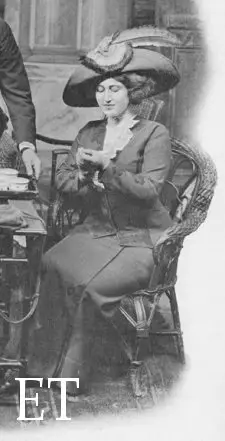 |
| Rita circa 1910. |
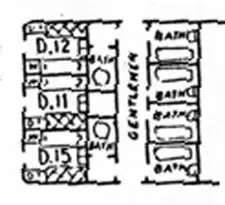 |
| Jolivet Cabin (D-15) (Courtesy of Paul Latimer) |
Rita Jolivet, stage and screen actress, remains one of the most frequently referred to of the Lusitania passengers. Unlike many others survivors, she apparently assimilated the memory the disaster quite well: although she spoke frequently of the sinking, she did not seem haunted by it, and the nightmares, panic attacks, guilt and anger which plagued the later years of so many of the Lusitania’s people do not seem to have been a major factor in her life. Her fame as a survivor has outlasted the acclaim of her dramatic career, and her 1917 testimony remains the best, and least fanciful, account of her experiences on May 7 1915.
Q When did you make up your mind to sail; when did you go on the ship?
A At 8 o’clock in the morning I made up my mind to sail, and I arrived at the dock at five minutes to ten. She was due to sail at 10 o’clock. The reason for my doing so was because the Lusitania was supposed to go quickly, and I wanted to see my brother before he left for the front.Q Had you expected, or thought of going on the St. Paul that same day?
A Miss Ellen Terry had suggested my going, and I said no, that I was in a hurry and was on schedule time and was afraid of not seeing my brother.Q When did the steamer finally sail, as far as you recollect?
A She finally sailed about 1 o’clock.Q Your stateroom was on what deck?
A On Deck D; it was a very bad room, because it was the last moment, and I had to take an inside cabin.Q Were you alone?
A Yes, but to my great surprise I found my brother in law was going back too. I met him on the boat. He had also decided to hurry back to his wife, and she was in England.Q There was no special circumstance on the voyage up to the day of the torpedoing?
A Not at all, except for rumors.Q On that day, on the 7th of May, Friday, did you notice anything about the speed of the vessel, as compared with her former speed?
A Yes, I noticed that she had slowed down.Q On Friday do you recollect seeing the shore at all, and if so, about what time?
A I saw the shore when I was in the water.Q Did you see it while you were on the steamer at all?
A No sir, because I had not slept well the night before and I had just got up for luncheon, and as I had an inside cabin I could not see the shore from my cabin.Q Where were you at the time the torpedo struck the ship?
A I was down in my cabin on deck D.Q Did you feel one shock or two shocks?
A I felt a great shock, and I was thrown about a great deal, and she listed tremendously.Q How soon did she begin to list after the shock?
A It seemed almost immediately; I didn’t think we were torpedoed, I thought we had struck a loose mine.Q What did you do after you felt the shock?
A I looked out and saw a woman putting on a lifebelt, so with great difficulty I climbed up and got hold of my lifebelt which I carried in my hand.Q Where did you get it?
A From the top of the wardrobe; I climbed up on my bunk and got hold of the lifebelt. I believe there was a second one there, but I couldn’t reach it very well. Then I climbed up on deck; I wanted to meet my brother in law who was waiting for me on deck A.Q You have spoken of the list that came immediately. Was that before or after you left your cabin?
A Before I left my cabin; with great difficulty I walked through the corridor and walked up the four flights of stairs to deck A.Q You found whom there?
A I found my brother- in- law and Mr. Charles Frohman, and a Mr. Scott. I believe there was another gentleman behind, that they said was Mr. Vanderbilt, but I don’t know; I am not sure of that.Q Did you put on your lifebelt then?
A No; my brother-in-law said “Did you bring any others?” and I said “No,” because I couldn’t reach the other. In fact, I didn’t know that there were other lifebelts in my room; there were, but I didn’t know at the time, in the hurry I just grabbed the first one. Then Mr. Scott went downstairs to deck B and he got up four lifebelts, and gave one to my brother-in-law, and one to Mr. Frohman, and one he kept for himself. And while he was helping Mr. Frohman on with his, and my brother-in-law was helping me with mine, someone stole his (Scott’s) lifebelt, and Mr. Scott went down a second time and brought up other lifebelts from deck B, and he gave his away to an old woman. We all offered him ours, and he said no, he could swim better than any of us, and if we had to die we had to die; why worry?Q Did you see any of the lifeboats lowered while you were up on deck A?
A Yes. We agreed to stick together and I looked out on the deck and I saw a lifeboat being lowered, but the guard slipped; it was not lowered evenly, and the women and children were thrown out.Q Do you remember which side of the ship that lifeboat was on?
A I am not quite positive; I am not quite positive but I think it was on the side that was nearer the port, nearer the shore.Q That would be the port side?
A Yes, that would be the port side.Q Did you notice anything about the list of the vessel as you stood up on deck A, whether it listed the same or whether it increased or not?
A No, it did not remain the same. She righted herself. She seemed to right herself. It was only noticeable at the beginning.
(An article regarding George Vernon and Rita’s sister Inez
in concert from the London Times 1902.Q How did you finally get off the ship?
A My brother-in-law took hold of my hand, and I took hold of Mr. Frohman, and we went out through the door on to the deck, and the water swept me away from my brother-in-law and from Mr. Frohman, swept me with such force that my buttoned boots were swept off my feet. I was struck under the water. I sank down twice. When I got up again there was an upturned boat on which I put my hand and clung to…the boat I clung to had canvas on it, and as a great many other people were clinging on to it we were sinking, and then came from under it a collapsible boat that carried away the extra people. We remained out there for three hours and a half, and were picked up by a Welsh collier.
Funeral of Charles FrohmanQ Was this lifeboat you clung to a regular lifeboat or a collapsible boat?
A It was a regular lifeboat.Q When you went over the side was the water up to the deck?
A It was the water that swept me away.Q Water came on the boat deck?
A Yes.Q That part of the ship was down practically at the water’s edge?
A Oh, it had already sunk; it was the water coming up, you see.Q The lee side was under water then?
A Yes.Q On what part of the deck were you?
A I was in the middle of the deck.Q In the middle from side-to-side?
A In the center near the elevator; near the lift.Q From side to side?
A Yes; then we went out on to the deck and saw the ship was sinking right away, and waited til; the last moment, you see, and then she sank…
In Queenstown, Rita was in the company of Amy Pearl, who lost two of her four children, Maude Thompson widowed by the disaster, and the injured Lady Marguerite Allan who lost both of the daughters who accompanied her on the voyage.
Although not mentioned in her account, it is likely that Miss Jolivet was also in the presence of survivor Beatrice Witherbee, who lost her mother and son in the disaster.
As related in part one of this article, Beatrice was moved from a “nursing facility” in England to the Jolivet residence, where she met Rita’s brother whom she married in 1919. Rita remained in touch with Amy Pearl for a time, and Amy’s daughter recalled that the two often visited one another. She may also have kept in contact with Lady Marguerite Allan, for she married Sir Montagu Allan’s cousin, James Bryce-Allan in the 1920s. A private film of the wedding was made and has survived, unlike most of Rita’s commercial output
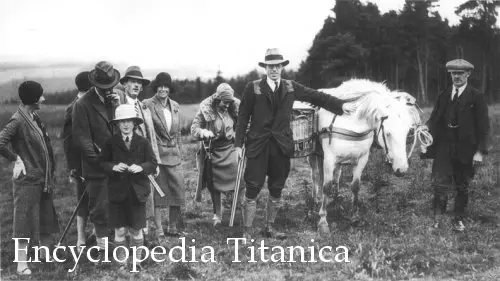
Scotland, early 1930s
Left to right: Trixie Witherbee Jolivet, Lawrence Jolivet, Alfred Jolivet, Lady Jose Bebb,
Count Henri Gaillard, Gladys Lee, Rita Bryce-Allan, Jimmy Bryce-Allan.
(Lawrence Jolivet)
“We all liked Jimmy. It was Rita my parents found annoying…..”
— Lawrence Jolivet, asked if his parents got along with The Bryce-Allans, 2005.
Her career as a performer tapered off by the mid 1920s, and thereafter she concentrated on her work as a critic, and on her social obligations and travel. James Bryce-Allan had been surprised to discover after their marriage, that Rita was quite a bit older than she had claimed to be, but the pairing of the reserved Scotsman and the flamboyant English-raised French actress proved to be successful and lasted until his death. The friendship between Rita and Beatrice Witherbee Jolivet became strained over the years, due in part to their greatly differing personality types: Rita’s habit of introducing her brother Alfred, nearly a decade younger than herself, as “my older brother” with its implication of “… and his older wife” annoyed Beatrice and her husband a great deal.
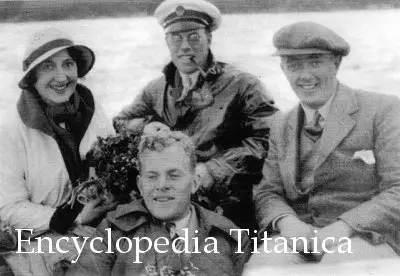
Rita Jolivet and her husband, James Bryce-Allan aboard their yacht, the Scotia in the mid 1930s.
The captain, who is the gentleman on the right side of the frame, ironically bore the last name Turner.
(Courtesy Lawrence Jolivet)
Rita died in surgery on March 2, 1971 after being injured in a fall while dancing. She had been demonstrating that she could still dance a jig, when she stumbled and broke her hip. Beatrice Jolivet, upon learning the details of her sister in law’s fatal accident remarked “Oh well, she would go like that.” True to form, Rita’s last words were a lie about her age; “I’m only 77,” although she was actually in her 80s. One of her final films, a surreal French comedy by the title of Phi-Phi (1926) surfaced a few years back and was screened in Europe to critical acclaim in 2003, which doubtlessly would have pleased her.
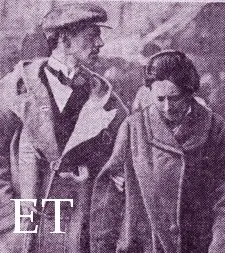 |
| Beatrice Williams with Mr. Lane of the Royal Gwent Singers (Daily Sketch) |
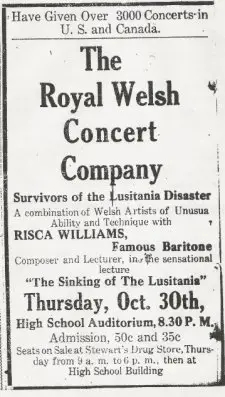 |
John Preston-Smith was a member of the Royal Gwent Singers from Wales, but he was not Welsh. He was born in Southbanks, Yorkshire, but as his wife Anne later noted, “He was connected with the ‘Welsh Singers’ for so long, he seemed one of them.” He and the others had been touring the United States, performing in the principal cities and giving special recitals before President Wilson, Andrew Carnegie and John D. Rockefeller. They remained in Brooklyn during the March and April, performing in various churches.
There were 14 singers and all, and they were to have sailed back to England on the Transylvania, but 9 of them transferred to the Lusitania. Dewi Michael explained why. “Some of us, too, thought as a matter of fact, that it would not only be more expeditious but safer to travel with the Lusitania.”
Survivors remembered the choir standing at the rail when the ship sailed. They sang, “Star Spangled Banner” and “Wales, my Wales.”
Reverend Henry Wood Simpson had brought along his viola and violin and provided musical accompaniment to the singers when they performed.
The gentlemen in the choir were called upon during the ship’s concert to entertain the passengers. Dewi Michael later recalled the final song of their conductor George Davies. “He was so loved by us… Strangely enough, the last song he sang was ‘Down with the Salamander.’ A strange coincidence that he should have been singing that when he himself would be going down. He sang it well too; I fancy I can hear his beautiful bass voice now.”
The group was at lunch when the ship struck. They stayed together only a short time, and in the confusion, became separated. Preston-Smith was with Beatrice Williams and they ran back downstairs to get lifejackets. Miss Williams was placed in a boat and told to get out again. “The ship was listing so heavily,” she said, “that I had to jump. Mr. Preston-Smith jumped with me and I was picked up and put on a raft.”
The end of the Lusitania came quickly and Preston-Smith noted
“I got washed away about 100 yards, and then I got a hold of deck chair on which I rested for about 20 minutes before I got on a raft. I helped four others to get on it, but the raft was over-loaded and began to sink so I took to the water again, as I was the only swimmer. I got on a little iron tank, and held onto that for two hours, though it toppled over several times… It was a Yorkshire man who pulled me out of the water at last, and for half an hour after being rescued, I was utterly helpless. They also pulled out an Irishman named Doyle, who was singing Irish songs in the water. He had gone quite daft. We pulled six women and three men out of the water, and two of the women subsequently died. Whilst swimming towards the raft, and almost done up, a woman swept past me propped up with lifebelts and deck chairs all around her. She asked for assistance, but I was too done up to help her, because by now I had lost the use of my legs. She said she was about done too, ‘but, I am going down like a Briton,’ she added. Just then, a raft came by and picked her up, and all the boys on the raft gave a hearty cheer. They just went crazy with joy at being able to rescue her.”
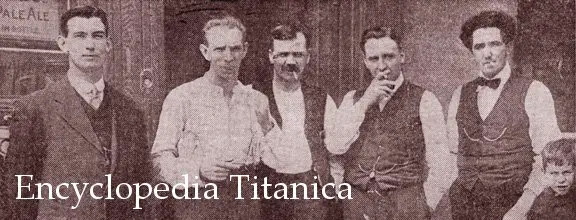
Royal Gwent survivors photographed in Queenstown
William ‘Spencer’ Hill claimed in his account that he, Thomas ‘Risca’ Williams, William Gwynn ‘Parry’ Jones, and John Preston-Smith managed to get to the same raft and began singing, ‘Praise God from Whom All Blessings Flow.’ “I don’t think I have ever heard it sung with more feeling,” he said. “Then some of the women began to cry and as that would not do, we struck up ‘Tipperary,’ and then they laughed.” Spencer Hill may have been misquoted or was incorrect in claiming that John Preston-Smith was with them. Preston-Smith was one of 11 people rescued by the Heron and brought into Kinsale. These people included Julia O’ Sullivan, Joseph Thompson, Stanley Critchison, Michael Doyle, Charles Hotchkiss, Frank Toner, Vernon Livermore, Cornelius Horrigan, Harold Rowbotham, and Fred Bottomley.
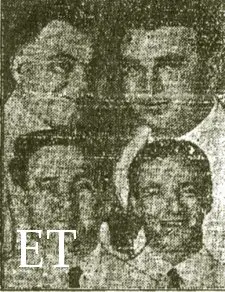
Royal Gwent Singers (among them John Preston-Smith):
a post 1915 publicity photo
(Michael Poirier)
Following his rescue, John Preston-Smith married Anne and continued to tour with choir; sometimes together and sometimes in smaller groups. As late as the 1930s, Risca Williams gave lectures on the group’s survival. The Preston-Smiths moved from Wales to Racine, Wisconsin in the 1940s. He had a stroke a few years later that left his right side paralyzed. When Adolph and Mary Hoehling were writing Last Voyage of the Lusitania, they contacted the couple. Anne dutifully sent the answers to any questions with which John could help and provided clippings about her husband’s involvement in the disaster. She also noted that they were still friendly with Beatrice Williams Harper, whose life John had helped save, and also with ‘Parry’ Jones. John Preston-Smith passed away on February 9, 1957 and was buried in Mound Cemetery in Racine. Titanic survivor Jennie Hansen is buried in the nearby Calvary Cemetery. Anne Preston-Smith moved back to Wales and died in 1973.
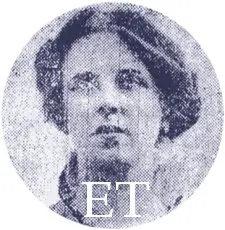 |
| Millie Baker |
Millie Baker was another Lusitania passenger with show business aspirations. She had not, at age 27, achieved the same level of success as Rita Jolivet, nor had she garnered favorable reviews to compare to those of Josephine Brandell, but she had completed several years of schooling as an opera performer in France and was hoping to make her debut at the Opera Comique.
She died in the disaster, and with her went her aspirations and whatever talent she may have possessed. Millie was the sole support of her foster mother with whom she had enjoyed a cordial relationship, and to whom her $2000.00 life insurance policy was left. Mrs. Baker was granted $15,000.00 by the Mixed Claim Commission, $14,800.00 of which covered the estimated value of Millie’s lost jewelry and wardrobe.
There was a side of Millie not preserved in the official record, and perhaps not known by her grieving foster mother. The unknown opera student was traveling in a very select circle, as the only quote we have located regarding her aboard the ship attests:
Presently, a party of us came together: Vanderbilt, C.F. Williamson, a dealer in antiques of Paris and a great personal friend of Mr. Vanderbilt; Edward Gorer, an art dealer of Bond Street; Mr. Slidell, a newspaper correspondent; and a lady known to us all, who lives in Paris, Miss Baker…
~George Kessler
The phrase “A lady known to us all” has a sense of familiarity to it uncommon in 1915 accounts. One cannot imagine it applied, with its mild sexual subtext, to Mary Hammond by any of the survivors. One notes that in contemporary interviews men were always very specific concerning the nature of their relationship with women other than their wives, mothers or sisters to avoid casting aspersion (“Who was the wife of a business acquaintance” “Who was introduced to me by Mrs. ___during the voyage” “Who sat at my table in the dining saloon” being typical of this) and it seems that Mr. Kessler may have been intentionally casting aspersion. Miss Baker was ticketed with C.F. Williamson, who paid for her passage, and they traveled in cabins that faced one another across the same hallway.

Williamson / Baker Cabins (B-34 / B-38)
(Paul Latimer)
C.F. Williamson, 40, was officially described as being an art dealer, connoisseur and commissionaire. He had realized at least $92,000.00 from the sale of a collection he exported to the United States from France in late 1914, and doubtlessly that sum allowed him to live his described ‘affluent’ lifestyle. As stated by George Kessler, Williamson was personally friends with the highest levels of New York society, and his friendship with A.G. Vanderbilt had brought him brief notoriety when he became a player in what was perhaps the greatest scandal of Vanderbilt’s life. A.G. had been conducting an affair with Mrs. Mary Agnes Ruiz, who committed suicide in London when things soured between them. Williamson, who was described as Mrs. Ruiz’s “agent” and who was renting her Paris residence, hurried to London, dismissed her servants, took charge of her affairs and supervised the disposal of her possessions. He gave a deposition at the inquest, but the details were sealed by the court. The verdict was “suicide while of unsound mind.”
After Williamson’s death, it was discovered that he owed large sums in the form of unsecured loans made by A.G. Vanderbilt, George J. Gould and others. It was also discovered that Williamson died close to broke. His family assumed that he must have hidden his lost-never-to-be-located wealth somewhere outside of Paris to prevent it from falling into German hands, but the fact that no books or accounts were ever found to document Williamson’s personal or business worth implies that, perhaps, he may have been a charlatan. The disposal of his estate brought in $140,500.00, which allowed his debts to be paid off at the rate of .82 on the dollar.
Williamson contributed to the upkeep of his aged father, and gave generously to the support of his sister, married to a terminally ill man. These illustrations of the better side of his nature allow one to suppose that, if they were together during the disaster, Williamson stuck with Millie until the end. However, their story, or stories, have been lost, leaving Kessler’s odd remark as the final word on the couple.
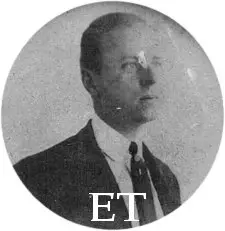 |
|
| Charles Harwood Knight (Nancy Dorney) |
|
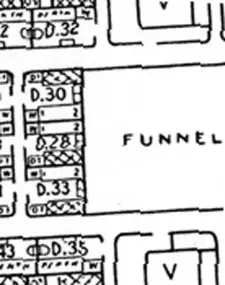 |
|
| Knight Cabins (D-32, Harwood, D-35 Naina) (Courtesy of Paul Latimer) |
Millicent Harwood Hartt, of Dedham, Massachusetts, received a letter posted from aboard the Lusitania by her uncle Charles Harwood Knight and aunt Elaine ‘Naina’ Knight during the week of May 1st 1915. It was a thank you letter acknowledging the hospitality the Hartts had shown the Knights during their recent visit, and a sentimental keepsake, for the Knights were summering in Paris and would not be seeing Millicent again for some time. As a souvenir of the voyage they were about to take, Naina had sealed a copy of the First Class passenger list in with the letter.
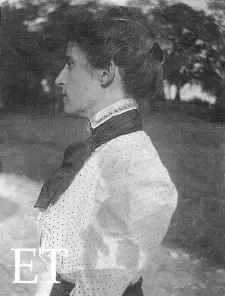
Elaine “Naina” Knight
(Nancy Dorney)
Millicent Hartt, the former Miss Harwood, had been orphaned while in her early teens. Her father died of tuberculosis, and then her mother, who had contracted the disease while caring for Mr. Harwood died as well. Millicent was sent to live with her only surviving relatives, Charles Knight, known by his middle name of Harwood, and his sister Elaine. The Knights, both in early middle age (he was 39, she 41 at the time of the disaster) led a genteel life. Originally from Baltimore, Maryland, they had resided in France for several years while Harwood studied piano. Harwood gave public recitals, and it is also said that he worked for the piano manufacturing firm of Sanders and Stayman. Millicent resided with them in until her marriage in 1910, at which point she settled in Massachusetts. She remained in friendly contact with her uncle and aunt although, as the eventual court case pointed out, she received no additional financial support from them after she married. The Knights returned to the United States, by way of Marseilles, in 1914, and their extended visit ended with a stay at the home of their niece and her husband in Dedham. They boarded the Lusitania intending to return to their Paris flat.
Charles Harwood and Elaine both died aboard the Lusitania, their bodies never recovered and no details of their final seven days preserved in the testimony of other survivors; gone without a trace. Millicent Hartt saved their letter, and the passenger list, which remain in the family to this day. She was the sole beneficiary of both estates, and was granted an additional $1750.00 by the Mixed Claims Commission for their lost effects.
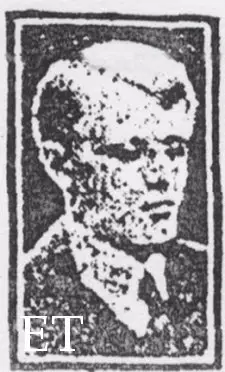 |
| Osmund Wordsworth (Paul Latimer) |
Luckier, by far, than Charles and Naina Knight were siblings Ruth and Osmund Wordsworth. They were taught at an early age how to swim, by a mother who insisted that all nine of her children possess the ability. This skill would come in handy on May 7, 1915.
Though he had a steady job as a lecturer in Classics at Trinity College, Toronto, Osmund Bartle Wordsworth, better known as ‘Barty’, wanted to join the English army. Ruth was going to visit her parents, Canon Christopher and Mary Wordsworth of St. Nicholas, Salisbury, after her first stint as a missionary in Tokyo, Japan. The siblings met in Canada to prepare for their journey home. They booked second-class passage on the Lusitania, on the May 1st crossing.
According to Ruth’s account, they spent most of their time on board together and did not socialize much with other passengers, but Barty may have known Reverend Hugh Carlton Syddall Morris, a fellow lecturer at Trinity College. Ruth found the crew to be friendly, especially stewardess Fannie Morecroft. “The last voyage of the Lusitania must have been one of the calmest and, up to the time of the disaster, the pleasantest,” recalled Barty.
All of that changed on Friday, May 7, 1915. The two went down to ‘D’ deck to the second-class dining room. While they were eating, Barty listened as…
“a friend told me at lunch that he had seen what he at first- no doubt rightly- took to be the conning-tower of a submarine, but afterwards was supposed to be a small boat. I had nearly finished lunch when the first torpedo struck the ship with an indescribably horrible sound, not a sharp report, but dull and deadened. There could be no doubt what had happened, and almost immediately the ship began to take a list to starboard. Everybody started up, but after the first shock there was no disorderly rush. I made my way onto ‘C’ deck. Before long, life-saving jackets were brought for those who had not got them already.”
While on deck, he found a hysterical elderly woman to whom he gave his lifebelt.
“It was perhaps a quarter of an hour after the first torpedo struck- the second I did not hear- that I heard a sound like breaking glass, and clouds of steam began to pour up. At the same time, the list was greatly increased, and it was clear that the ship was sinking rapidly. I made up my wind to jump, but slipped and fell. The deck was so steep that it was impossible to walk on it, but I managed, after kicking off my shoes, to make a spring and catch something by which I was able to pull myself up to the port side. I climbed over the rail, and was standing on the side, which was almost horizontal, when the ship sank.”
Somehow, in the confusion, Barty and Ruth were separated. She claimed to have waited until she was one of the last people to leave the dining room and went directly to her cabin to fetch a lifebelt. Along the way, she said there was no one in the corridor. She ascended the wide staircase to the boat deck. The list made the lowering of lifeboats difficult, Ruth witnessed many acts of heroism as men tried to help the women, and children get away. An explosion occurred, and she was knocked out. When she came to, she was in the water. She said that due to her faith, she did not fear death at all. She a glimpsed a lifeboat nearby and swam to it. Luckily, the people were able to pull her aboard.
“I felt no suction, and came up immediately, and had not been more than two minutes in the water when I was hauled on to overturned boat,” remembered Barty. “After a time, however, we saw a fishing smack coming towards us, and a little later the smoke of several vessels coming from Queenstown… I was taken aboard the H.M.S. Julia and there fed, warmed and given a change of clothing with that hospitality which characterizes the British Navy. It was long after dark when we reached land.”
Neither Ruth nor Barty knew how the other had fared. They had made a pact while aboard ship that should the worst happen, they would not try to find each other in the crowd, but to go directly to their boat stations. Each watched the incoming rescue ships, but did not find each other until the following day when Barty saw her name on a list of survivors and met an acquaintance who knew where she was staying. Supposedly, they were reunited in the street. The two left Queenstown that afternoon and took the ferry to England. It was a joyous reunion for the Wordsworth family, though Ruth had an extended stay in the hospital due to her injuries. Following a visit with his family, Barty joined the army. He rose to the rank of Second Lieutenant of the Machine Gun Corps of the 21st Coy. He was killed in action on April 2, 1917. By coincidence, Private Robert Hebden, another Lusitania survivor, was killed in action on the same day in France and both are buried in Arras Memorial Cemetery. Ruth went back to Tokyo as missionary where she worked for many years. A family member claimed that she once saved another missionary from drowning. Ruth Mary Wordsworth died in Taunton, England on February 21, 1953.
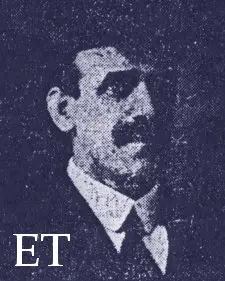 |
| Richard Joseph Danson |
Richard Joseph Danson was born in Birkenhead to John and Mary Danson in early 1868. He was one of several children and when each came of age, he or she had to find work. Richard started out as a shunter on the railway. Shortly thereafter, he found a job as a ship’s steward. Once he had a secure job and a steady income, he married his fiancée Mary in 1900. As of 1915, they lived at 12 Cavendish Street, Birkenhead.
On May 1, he boarded the Lusitania employed as an assistant pantry steward. He survived, to give an exciting account of his experiences.
“I was below deck at the time…and I came on deck right away, but she had already begun to list. I got a hold of a lifebelt and sat on the side as she went down, ready to jump, and I did so, but owing to the lifebelt, I could not get far away. I turned round and got ready to resist the suction, but she sank with hardly any.”
“One boat was alongside the sinking ship and owing to the list of the side they could not get it away. the davits came into the boat, like a pair of hooks. I saw them going slowly down, powerless to get the boat away. When she sank altogether, the boat turned over and several passengers came up, but they were nearly all dead.”
“I saw some horrible things when watching her go down… about four other people were floating in the water when one of the funnels went under and they were washed right in… The force of the compression shot them out about 20 feet and just a few yards from where they would be picked up right away.”
Recalling their appearance, he claimed they were “black from head to foot.”
He swam to a raft and for a while was the only one on it. Eventually about a half a dozen people were aboard. They transferred to a collapsible that was floating nearby and began pulling others from the water. A torpedo destroyer eventually brought them to Queenstown.
Physically he was all right except for what he described as stiffness across his chest and in his arms. Other than that, his only complaint when reaching shore was that he hadn’t eaten since that morning.
He had a positive attitude regarding his survival. “I wasn’t afraid of the sea because I’ve swum the Mersey and the Hudson.”
Danson continued to work as a steward, although not exclusively for Cunard. He sailed aboard the Cedric several times, before returning to Cunard aboard the Franconia. Richard Joseph Danson died in 1940 in Birkenhead at age 71.
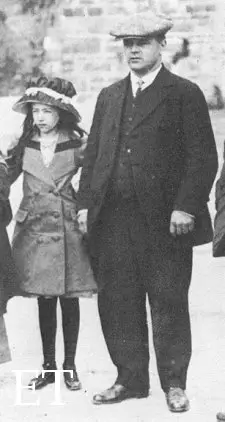 |
| Frederick John Milford with Elsie Lohden |
Like Francis Bertram Jenkins, Allen Beattie, and Gerda Neilsen, Frederick John Milford is a sad example of someone who could not overcome the memory of his experiences in the Lusitania tragedy.
Milford worked for the Metropolitan Life Insurance Company in Hancock, Michigan. His annual income was $2,500 a year. He boarded the Lusitania to visit his father in Cornwall, England while his wife, Ethel, remained at home.
“I was having lunch when I heard a dull crash, but it did not startle me at all. Very soon afterwards I heard women screaming, and then hurriedly made my way to the deck. The vessel in a short time began to list to starboard, and nearly a score of the boats on the port side were filled with passengers, but it was found impossible to lower them owing to that side of the ship standing so high above the water. I managed to get across to starboard. The ship’s deck was then level with the sea. I made for a boat which was just putting off, and, in fact, had one foot on the craft and the other on the ship. Then, owing to something wrong, the lifeboat jammed, and all the occupants were thrown into the water. It was a terrible moment.
The passengers in the boat, including women, screamed in terror and soon sank. Other boats collapsed or turned over, and hundreds of men, women and children were struggling hopelessly about, some frantically clinging to boats which had been upset. I struck out and managed, after swimming for about fifteen minutes to come across a boat in which I was dragged. Hundreds of people were on rafts, and the sea was alive with men and women.”
Milford’s boat was rescued by the Flying Fish and taken to Queenstown. He was photographed by the press in a group shot that has appeared in many books in articles, and is one of the best known Lusitania photos. He is shown with Mr. Collis, Mrs. Wolfenden, Mrs. Plank, and the Lohdens.
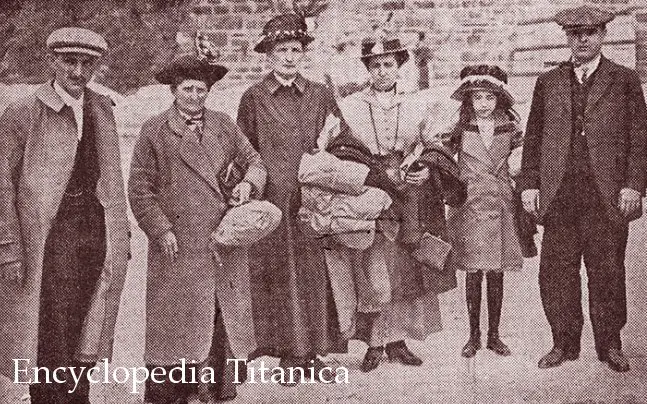
Frederick Milford at Queenstown with follow survivors.
Left to right: Mr. Collis, Mrs. Wolfenden, Mrs. Plank, the Lohdens, Mr. Milford.
Following his visit to Cornwall, he booked passage on the Philadelphia, which arrived in New York on June 2, 1915. He returned to work immediately, but could not put the disaster behind him. Over the next few years he was constantly in and out of sanitariums to be treated for his nerves. He developed diabetes, which he blamed on his Lusitania injuries. There was one bright spot in his life; His wife Ethel gave birth to a daughter, Marion around 1921.
Milford filed a claim against Germany for $25,000.00, only $281 of which was for lost possessions The balance was, presumably, for medical expenses and lost time. Edwin Parker, of The Mixed Claims Commission determined that $11,500 would be fair compensation and rendered his decision on January 7, 1925. Fred Milford died on January 5, 1927 at age 47.
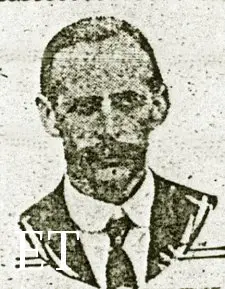 |
| Percy Rogers (Michael Poirier) |
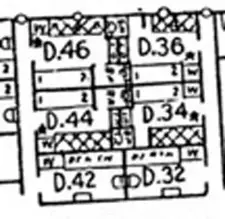 |
| Percy Rogers Cabin (D-44) (Paul Latimer) |
Percy Rogers, assistant manager of the Canadian National Exhibition in Toronto, traveled to Europe in May 1915 to obtain “war souvenirs” for display at the Exhibition. He was a last minute booking, filling in for his boss, Dr. Orr, who was unable to travel.
Rogers’ account of the voyage parallels most of the others: pleasant and uneventful, but with an increasing awareness of the war as the trip progressed and Europe drew closer.
“Everything went well till Friday morning. Submarines were the source of much conversation but were not regarded with any seriousness as opinions were frequently expressed that a boat with the speed of the Lusitania was more than equal to any submarines. Nobody was therefore disturbed with the thought of being torpedoed. Early Friday morning we sighted the Irish coast and entered into a slight fog. Speed was reduced, but we soon came into clear atmosphere and the pace of the boat was increased.”
Rogers finished the final lunch in the dining saloon early:
“I immediately proceeded to my stateroom, which was close to the dining room to get a letter which I had written. While there I heard a tremendous thud…
Passengers hastened to the boat deck above. Lifeboats were hanging out, having been placed in that position on the previous day. The Lusitania soon began to list badly, with the result that the side on which I and several others were standing went up as the other side dropped…the first lifeboat which was lowered with people at the spot where I stood smacked upon the water, and as it did so the stern of the lifeboat seemed to part and people were thrown into the sea.
We heard someone say ‘get out of the boats; there is no danger’ and some people actually did, but this direction was not generally acted upon. I entered a boat in which I should say there were between 20 and 25 women and children, and also some men. Our position was the last boat but one from the stern of the ship. We dropped into the water and for a few minutes we were alright. Then the liner went over. We were not far from her. Whatever the cause may have been, perhaps the effect of the suction, we were thrown into the sea. Some occupants were wearing lifebelts. I was not.”
Given this description, which matches several other accounts, it appears that Rogers was in boat #14, with Virginia Loney.
It is harrowing to think of the men, women and children struggling in the water. I had the presence of mind to swim away from the ship and towards a collapsible boat…for this purpose I had to swim quite a distance. This boat began rocking. Every moment it seemed as if we should be thrown into the sea.
While in the collapsible, Percy Rogers saw a familiar face nearby in the water:
I saw George Copping clinging to a rope, almost exhausted…’My wife is gone and I can’t hold out much longer’ were his last words.
Rogers left the imperiled collapsible, reentering the water to swim to a floating cupboard.
People around me were drowning. I remember seeing a young girl with a lifebelt on calling ‘mamma,’ but she was not saved. I had seen her on the liner before and noticed her sister on a collapsible boat. I saw a cupboard, towards which I swam and managed to support myself until I saw a boat. I shouted and was taken on board, and from there was transferred to a trawler. Eventually we were placed on the Flying Fish and reached Queenstown about half past ten. I was soaking wet, and went into a small hotel where a lady was kind enough to give me a pair of pajamas and socks. In the morning I went into a clothing store and purchased a suit. All my belongings were lost.
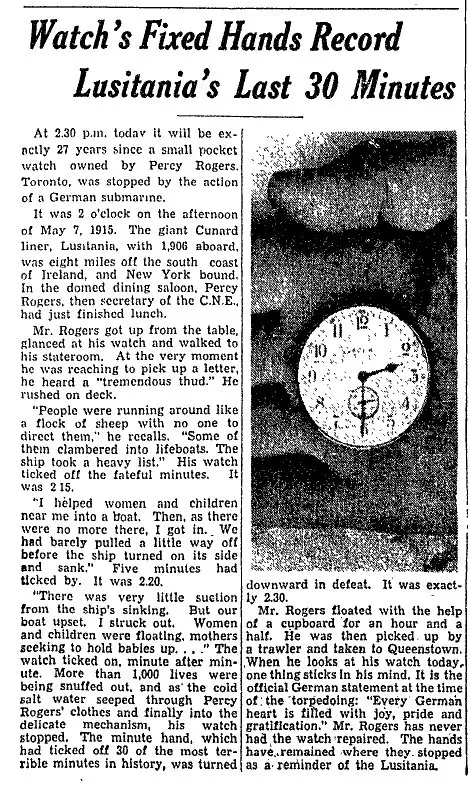
Toronto Daily Star – 6th May 1942
Rogers survived physically uninjured, but like many other survivors suffered from “nerves” in the years following the disaster. He returned to Canada via NY aboard the St. Paul during the summer of 1915 carrying with him, amongst other exhibits for the exhibition, a model of the U-20 type of submarine and replica of the torpedo which destroyed the Lusitania. However, he was unable to carry out his duties at the Exhibition and was forced to resign. He suffered a “general breakup,” which can be assumed to have been a mental breakdown, and required sporadic medical attention for his condition. An attack of appendicitis was blamed, by him at least, on his having been pulled over the side of a lifeboat. The Canadian Courts disbelieved that claim, but allowed him a settlement of $6500.00 for injury and loss of earning power, and $513.75 for lost personal effects.
He died at age 98, on October 5, 1967. He was predeceased by his wife, Ida and survived by two of his four children.
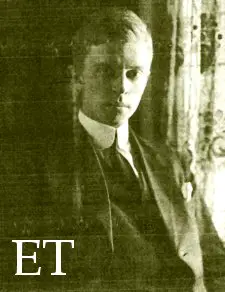 |
| Edwin Friend (Harvard University Archives: Call # HUD 308.04.5) |
An emotional blow of a different sort struck the widow of Edwin Friend. Friend, by nature of his relationship with Theodate Pope and his appearance in her oft-quoted letter account remains a high profile victim, but the depressing final act of his story is little remembered.
Edwin Friend was a Harvard graduate, who worked as a lecturer at both Harvard and Princeton. He was also a devotee of spiritualism, serving as the secretary of the American Society of Psychical research, and it was this interest which brought him, together with Miss Pope, aboard the Lusitania.
Miss Pope and Mr. Friend’s experiences aboard the Lusitania as she sank have been documented exhaustively elsewhere: the two remained together for the duration, along with Theodate’s maid, Emily Robinson, and when it came time to jump Edwin went first and smiled “encouragingly” upon coming to the surface. Theodate jumped seconds later and was washed into the submerging promenade deck; against all odds she survived, while Mr. Friend who apparently got clear of the ship did not.
Marjorie Friend, Edwin’s wife, was pregnant at the time of her husband’s death. Theodate and her mother interceded, and gave the young widow financial support and a place to stay during the late stages of her pregnancy. They soon came to regret their generosity, as they were extremely disturbed by the fast social life Mrs. Friend seemed to be leading. Her and Edwin’s only child, a daughter named Faith, was born “mentally defective” on September 22, 1915. Marjorie blamed this turn of events on the stress she had endured after the disaster and successfully filed a claim against Germany. A sum of $10,000.00 was awarded to Faith, in trust of her mother, to be used to maintain the child in the Massachusetts School for the Feeble Minded where she had long been a patient.
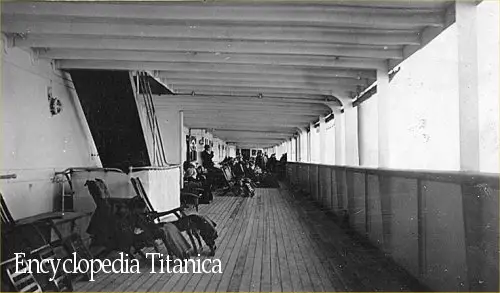
Promenade Deck
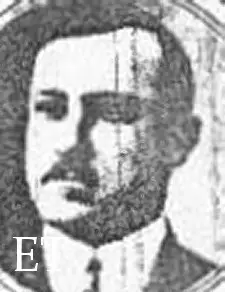 |
| James Leary |
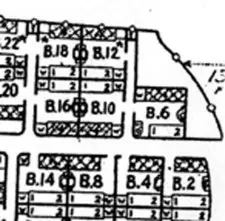 |
| Leary and King Cabins (B-14 King, B-16 Leary) (Courtesy of Paul Latimer) |
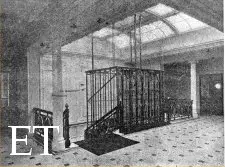 |
| Lusitania’s Elevators (Scientific American) |
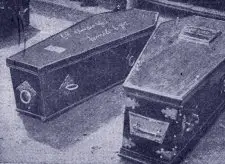 |
| The coffins of victims Thomas Boyce King and Lily Lockwood, photographed in Queenstown. King would be returned to the United States, while Lockwood, a child who was lost along with her mother, Florrie; brother, Clifford; and aunt, Edith Robshaw , was buried in one of the common graves. |
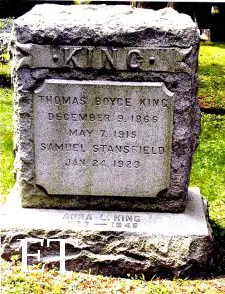 |
| Grave of Thomas Boyce King Greenwood Union Cemetery, Rye New York. |
James J. Leary, of Brooklyn was a buyer for Brokaw Brothers. He embarked on the Lusitania with his friend and fellow Brokaw employee Thomas Boyce King, and survived to give graphic testimony about his Lusitania experiences.
Leary and King, in common with most of their fellow travelers did not learn of the German warning until they were aboard the ship. Details of how they spent their time aboard the Lusitania are few, and with the exception of Leary winning the ship’s mileage pool, it seems that their voyage was pleasantly unexceptional. He spent the final morning walking on deck after having breakfasted in his B deck cabin, and observed that the Irish Coast was clearly visible. He also noted that the Lusitania was traveling at a very slow rate, a fact on which nearly all of the survivors were in agreement.
They had a drill one morning, about 10 or 12 men out on the starboard side. Mr. King passed the remark to me “How would you like to take your chances with that crowd in case we are torpedoed?”
Mr. King and myself went down to the dining room and we had our lunch; it was his custom to leave right after lunch to go and take some medicine, and I went to a table with Mr. Campbell, Mr. Battersea (sic Battersby) and Mr. Hardwick….that was right inside the dining room three tables from the entrance.
We conversed a little while and then we started out to the deck, and just got out the threshold of the doorway when we got the explosion of the torpedo. It sounded to me like a terrific explosion like what you would hear in an excavation in the subway. I went up to C deck, and the stairway was quite crowded, and then I went over to the side of the ship, to look out, to try to find where the torpedo hit. I saw this tremendous hole, and I saw the people jumping off and lowering the lifeboat, which seemed evidently cut away from the side of the ship, and this boat was filled with passengers and they were all thrown in the sea, and the boat swung in the air on one rope.
The lurid tale of first class passengers trapped in the ship’s elevator cages and sinking with the ship has become an integral part of the Lusitania legend. ‘though it surely could have happened, the earliest account of this aspect of the tragedy we have found is contained in Leary’s flamboyant testimony:
When I came from this entrance where I went out to look at the hole in the side of the ship, I looked at the ventilators (elevators) and looked up and noticed that they were between the two floors, filled with passengers screaming, and evidently they could not go up or down because the boat was on such a list, and I imagine that is the way they died.
The next paragraph must be viewed with skepticism. Recall this passage when reading Leary’s 1915 account which follows:
I started to look in the different rooms for a lifebelt; they were all gone. My room was so far forward and the boat was on such a list that I thought it would be impossible for me to get to it, so as I went along I saw an officer coming along with a lifebelt in his hand…everybody was running around and screaming and looking for a belt; so I saw him, I met him in the companion (way) going towards this room and I was trying to get the lifebelt. I had exhausted every place and could not get a belt, and saw him with one in his hand. I asked him for it, and he said “you will have to go and get one for yourself; this is mine.” I said “I thought according to law passengers come first.” He said “Passengers be damned; save yourself first.” I tore it away from him, and I said “you can find one quicker than I can, and if you want this one you will have to kill me to get it.”
When pressed to identify this officer, Leary could not. Nor could he give a detailed description, and even his general description was vague. The event may have happened as Leary said it did, but it seems likely that the man in question was simply a member of the crew..
I went up to A deck to look for Mr. King. I said to him “Well, Tom, we finally got it.” and he said “Yes, I knew it all the way over.” I started to put my belt on and got it upside down and this chap came along and said “if you got in the water that way you would be feet up.” So he put it on for me. You are supposed to put it on like a vest, and I put my hands in it. There is a collar that fits in the back of the neck and I had it on front.
What follows, though sounding as far-fetched as many of Leary’s other claims, is attested to in many of the accounts given by port side survivors. May Maycock, Sarah Lund, Joseph Myers and Robert Timmis are among those who left record that the principal reason none of the boats on the port side escaped was not so much the list but that the passengers were ordered out of the boats by the crew, after which no additional effort to lower them was made.
We were standing right below the captain’s bridge, and Captain Anderson was standing on this little bridge and he was shouting instructions to the different seamen; so I remember he hollered “lower no more boats. We have closed certain bulkheads in the ship and she won’t sink, and we can get into port.” I met McCubben, (sic McCubbin) the purser. I had all my valuables in the safe with him, and I said “how about my valuables” and he said “young man. If we get to port you will get them, and if we sink you won’t need them.”
I met Mr. King again. And we stood there, and there was a lifeboat in front of us and we had to lean up against the wall on account of the boat being on such a list…I said “I think we had better take our chances on deck” so we did not try for the lifeboat. Then just a few minutes after there was another explosion that seemed to me like the boilers. Of course all the soot and coal dust and different things came through the ship, and everybody got covered with it, and then she took a plunge.
As it was going down, this lifeboat that was in front of us that the people got out of after the captain had given instructions, and through some insane idea I had I jumped in, and she was tied there, and that was the way I went down. As the boat went under water something caught on my leg; I think it was the oars that criss-crossed and held me fast, and it seemed to me I went down as far as the ship did. There was a terrible drag from this thing holding me, and she seemed to settle more then and I kicked myself free and came up.
I saw an upturned lifeboat and swam to it and hung on to it by my fingers. There happened to be three or four stokers or seamen hanging on with me. We were 20 in all, and we decided to turn her over, and we got on our stomachs and turned it over, and when we got it turned over she was covered in canvas and ropes all through different parts, so it was impossible to take the covering off. So we stood on that and a wave would come along and we would go over, and would be pulled back, and we did that for half an hour. Every once in a while we would miss one or two, and the bodies would float around, and we would push them away when they were dead. We went on for four and a half hours before we were picked up by a British destroyer. There were only six of us left in the end.
Leary’s 1917 testimony is dramatic in the extreme, and one suspects that a degree of “grandstanding” was occurring as he spoke. His 1915 account tells essentially the same story, but in a considerably sparer manner, bereft of lurid details such as the passengers trapped in the elevators, the interlude with the officer refusing to part with his lifejacket, and the hole in the side being visible.
At lunch on Thursday the lifeboats were swung out. That night all lights were extinguished or observed. A Mr. Winters who was connected with the Cunard Company said that morning wireless messages had been received and that there would be no more lights allowed at night.
From about 1:30 AM to 2:30 AM on Friday I was on deck and saw a light some distance away a beam which gradually disappeared as we left it behind. I was berthed on B deck (Leary was in B-16) and found a blotter placed over my skylight that night to obscure the light.
I dressed and came on deck on Friday at about 12:30 PM. I left the luncheon table at about 2PM and was just outside the dining room door when I heard an explosion, and felt a very heavy shock after which all the lights went out.
Everyone hastened up on deck; there was no panic. The torpedo struck on the right hand side; the rails and deck were a mass of wreckage about amidships.
The crew lowered the life boats; women and children only were allowed in them.
I didn’t realize the danger and went to my stateroom for a life preserver, but couldn’t get one in the dark. I searched for two but couldn’t find any so got one from a member of the crew.
I then found Mr. King, Thos. B. on A deck and said to him that “we’d got it” meaning that we’d been struck by a torpedo. He assented calmly; there seemed to be no excitement.
The staff captain announced from the bridge “lower no more boats” and said that he could reach port before the vessel sank. Officers and crew carried the same word to the passengers.
In less than 5 minutes there was another explosion. Mr. Alfred Vanderbilt’s suite was full of black smoke and wall dust.
Then the ship took a list and the passengers got excited and not more than two or three minutes afterwards the ship went down. I lost Mr. King. One of the lifeboats was already swung out and I jumped in, but there was no one to lower it.
I went down with the boat and my foot was caught in some wreckage.
When I came up, I reached an overturned lifeboats and was on it for four hours, with twenty others slipping off and on all that time.
At six o’clock PM we were picked up by a torpedo boat. There were only six of us left, all exhausted. We were then well taken care of and brought to Queenstown.
Both accounts tell the same story, yet one if left wondering about the various details added to the 1917 rendition. Did Leary embellish, or was he simply able to expand upon his 1915 story because the 1917 version was given verbally rather than in manuscript form?
Thomas Boyce King, Leary’s friend and coworker from Brokaw Brothers, did not survive the disaster. His body was recovered, and a photo of his coffin run in the UK newspapers. In one photo caption he was described as an “American millionaire” but, in fact he was merely comfortably well off: he earned approximately $9500.00 per year for the last five years of his life. He was laid to rest at Greenwood Union Cemetery in Rye, New York, near the home he shared with his wife, Anna, and son Thomas Boyce King, Junior. Mrs. King married a UK national by the name of Samuel Stansfield, who survived only into the 1920s and who, upon his death, was buried beside Mr. King. Anna King Stansfield died in 1946 and now rests with both of her husbands. Thomas B. King, Junior died in November 1974, at age 71, in Yonkers New York.
I think that if the Cunard Line had practiced the manning and getting away of the boats, and the proper assignment of officers and crew to the lifeboats the loss could not possibly have been one third of what it was. It is nonsense to say there was no confusion. There was panic. There was no discipline at all. Worst discipline I ever saw.
So concluded Joseph Myers, a lace manufacturer from New York, whose business concerns in Europe assured that he was a frequent transatlantic passenger: he had made over 100 round trips during the course of his career and consequently had a better understanding of how ships operate than most passengers on board the final voyage.
Myers had transferred to the Lusitania from the American Line’s St. Paul, believing that he would save at least a day’s travel time by taking the faster liner. He realized while aboard that the Lusitania was traveling at reduced speed and would never make port by Friday May 7 as he had hoped.
Myers had much to criticize about the final crossing. Describing the swinging out of the lifeboats on Thursday, he said:
The men were not efficient. I saw them trying to throw out the boats, trying to break away the boats from the davits, and it seemed to me that they were not equal to it. They were clumsy in handling the ropes. They were bossed by some petty officer; I don’t know who it was, but the men did not look to me as if they had been handling the boats before. (They handled the ropes and falls) like men building a house; they looked more like day laborers than seamen.
I could see it (the Irish Coast) very plainly, very plainly. I should imagine that before luncheon we must have been 10 or 12 miles away and gradually got closer to the coast. I could see very clearly the coast, and could see also, I believed, the lighthouse. Afterwards I found out that it was the Kinsale lighthouse….it was as near as we had ever gone; I don’t believe to my recollection that I ever passed very much closer to the coast, excepting once and then we went inside Fastnet. My impression was that we were nearing the coast considerably, just as if we were going to make port.
Myers took his luncheon with Francis Kellett of Tuckahoe, New York, after which both men went on deck in time to witness the sequence of events leading up to the torpedoing.
I was standing there with Mr. Kellett. We were standing there discussing the conversation we had had at lunch with another party. I happened to see a periscope and called attention to that periscope to Mr. Kellett.
Q What did that periscope look like?
A Like a periscope.Q Had you ever seen a periscope before?
A I had.Q How did you happen to see them before?
A I had been chased by submarines crossing the channel.It looked like a chimney. It was not very large. It was very small; it stuck right up out of the water like my hand, perhaps three feet. At the time I first saw it and called Mr. Kellett’s attention to it was just about in line with the captain’s bridge. I said “My God, Frank, there is a periscope” and I pointed it out to him. By that time the vessel had proceeded and the periscope remained stationary. I said “My God, Frank, they have put off a torpedo. My God, Frank, we are lost” and she struck.
There was water and coal dust and debris of all kinds blown up; they came through the funnel and up through the side of the boat, alongside the boat rather. I went into the Verandah Café to avoid the debris which was falling aft. I didn’t avoid it all…I went forward, and going along into a companionway of some sort, Mr. Kellett and myself. I went forward and he went aft to obtain life preservers, because I stated to him that we would never attempt to go below. I feared very much that we would never come up if we did go below…he seemed to have been the lucky one in finding the lifebelts. I tried two or three stewards lockers and tried to see if there was a room that had a lifebelt in it, but I was not successful forward. Mr. Kellett went aft and called to me, stating that he had one for me. I came to him and adjusted his lifebelt on him, and he helped me with mine. We got them on wrong. It was very singular that we should, because they had plenty of printed notices how to put a on a lifebelt in each room…I had never thought of putting on a lifebelt, and never anticipated any trouble on the Lusitania. I never heard anything about the warning or anything of the kind…
There was great confusion and lots of excitement. Everybody was pouring up through the companionway. The second class was coming up from their quarters trying to get on our deck, and they succeeded, and finally one of these passengers came up with a boy and asked if I wouldn’t help her into one of the lifeboats. I assisted her in, and assisted her boy in, and she begged me to come in the boat with her, because at that time there were very few men in that boat. She said “We really will require some men; for God’s sake come in and help me with my boy. Please don’t let this boy drown.” Mr. Kellett and I finally decided to get in that boat with these passengers and we stayed with that boat. There was nobody there to lower it… You had to get into that boat over the collapsible boat; there was a collapsible boat attached to the deck, and we climbed over it to get into this lifeboat that was swung out… She had plenty of room to go down if there was anybody there to lower her.
A bathroom steward that had given me a bath in the morning came aft, a big fat fellow with a lifebelt on, and he called out “Everybody out of the lifeboats. We are hard aground we are not going to sink.” We got out.
I saw them attempt to lower some boats, and I saw these boats fall, some of them…I think it was the boat opposite 15 that I saw fall, that is (it) ran down on one side and the passengers were all dumped out.
We remained stationary there for a time and finally decided that the deck was becoming a bit uncomfortable on account of the crowd that was coming up from all over. They were coming from the bow and the stern and crowding up around us, and I said to Mr. Kellett “Frank, the best thing we can do is get into this boat again and wait until she goes over.” … I did get back into this boat and waited for the big boat to go down, and I thought this would be the safest place to be thrown away from, but it was so aft that when she did go down we were thrown out… There were ropes around my body and I was being dragged down. I sat up in the bow of this lifeboat, underneath the davit. The block and tackle were right above me…and the ropes happened to be underneath me, and what happened I don’t know, except that these ropes were around my body and dragging me down.
I couldn’t do very much because I had my ribs broken and my leg broken and my arm very badly hurt. I laid in the water, and finally there was an overturned lifeboat coming pretty close to me, and I managed with my left hand to work my way over to this boat and hang on.
Joseph Myers was rescued by the Katrina later that evening and brought into Queenstown. Francis Kellett was lost, and his body never recovered. From Queenstown Myers wrote his mother a lengthy account of the disaster which corresponds to his 1917 testimony and contains a more personal look at Myers’ experience than he allowed himself to give at the Limitation of Liability hearings:
The Golding Nursing Home
Cork, IrelandMay 22, 1915
My Dear Mama: Marie wrote to you last week and I can now do so, although I am in bed and have been so for two weeks on my back. Oh, how it hurts. Well, I suppose you want to know what is the matter with me. My right leg is broken, my left leg is torn, the nerves all exposed under the thigh, three ribs broken front and back on the left side and two on the right, my right arm badly torn. This all happened after the second explosion- I am sure we were torpedoed twice. I saw the first leave the submarine and saw the submarine dive and saw the torpedo strike us and saw everything else. My God, what a sight. In twenty minutes we were gone. I went down with the ship. How long I remained down I don’t know, but it was while I was under water that I so badly got knocked about. Wreckage bumped me up against the ship under water and I fought like a devil. The face of my dear wife and our little boy was before me and I said to myself over and over again, ‘I can’t go. I must fight this out and win out for their sake.’ and that is what gave me strength and courage. Well, I was four hours in the water swimming and floating about with a broken leg and ribs, but not until I was pulled on a boat did I feel that I was hurt. They thought I was about gone. They took all my clothes off and rolled me about until I cried for help and mercy, then they found that I was injured, threw me into the engine room and left me there without anything on. We arrived in Queenstown the next morning at 2:30, just twelve hours after we went down. They put me in a naval hospital, where I remained until Sunday evening and was then transferred here without any clothes and now am on the road to recovery. Not until Monday did the Cunard company report me as saved, although I sent them my name on Saturday at 3 A.M., but their office in Queenstown can only by compared with the confusion on the Lusitania. When we were struck, all the officers lost their heads, boats could not be launched. Only two got away safe, all the rest were lost. Those four hours in the water, I shall never forget. I saw my friends and acquaintances float by dead, or almost so and I could not tender any help; I was too weak; It almost drove me mad. Thank God it was such a fine day and the water so warm. I had on a lifebelt and can swim and float. At 6:30 P.M. I was pulled on a Greek steamer which picked up fifty-two survivors and I was the last one saved. Your loving son, Joseph L. Myers
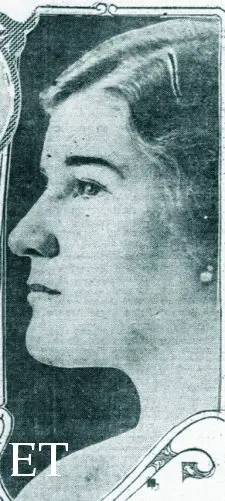 |
| Gladys Bilicke (Michael Poirier) |
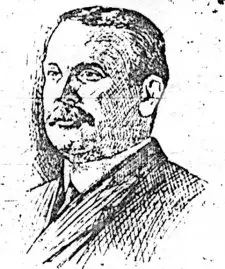 |
| Albert Bilicke |
 |
| Bilicke Cabin (B-48) (Paul Latimer) |
Albert and Gladys Bilicke, of Pasadena, traveled to Europe that spring so that Albert could peacefully recuperate from abdominal surgery away from the stress of his career in Los Angeles. Albert Bilicke’s was a success story straight out of the “Old West.” He was the son of German immigrants, who settled in the boom town of Tombstone Arizona. Albert and his father opened and operated the Hotel Cosmopolitan during the mining years, and the family prospered. Albert became friends with Wyatt Earp and his family and testified on Earp’s behalf at the infamous trial which followed The Gunfight at the OK Corral. He claimed that he saw Tom McLaury, one of the outlaws killed in the shootout, with what appeared to be a gun in his pocket. Albert was no stranger to violence, having once shot and killed a man who threatened his father with a gun.
The Hotel Cosmopolitan burned and the Bilickes moved on to California. Albert first operated a hotel in Santa Rosa and then went on to Los Angeles where he ran the Hollenbeck Hotel. He met and married Gladys Huff of Illinois. Shortly after their marriage, he began plans for his most ambitious project- the Alexandria Hotel. Ground was broken for the new edifice in 1904 and it opened a year later, soon becoming the leading hotel in Los Angeles. He then formed a partnership with R.A. Rowan, confounding the Bilicke-Rowan Fireproof Building Co. They built the Rowan Building and bought many properties in downtown Los Angeles. Albert began investing in property in Kansas City, Missouri, where his holdings were reported to be over $1,500,000.
The Bilickes had three children: Carl, Albert, and Nancy. Their home was 699 Monterey Road in South Pasadena, California. Friends and acquaintances received a lasting impression of beauty and permanence when they visited the estate. The house stood amid orange groves, and the lawns behind the house were terraced to a height of 50 feet over their residence. Below them, the valley rolled away to a view of the distant ocean.
All was going well for the family, when Albert suddenly became ill and needed abdominal surgery. Following the operation, his physicians advised that he and Gladys should take a short, recuperative trip. Their ‘short journey’ was cross country, terminating in New York. En route, they visited with friends and relatives in a number of cities. They stopped in Kansas City for a few days, and intended to return in time for the opening of the elegant new Muehlenbach Hotel.
While in New York, they decided to cap off the pleasant ‘short trip’ with a voyage aboard the Lusitania. Albert sent a telegram to his real estate agent, C.H. Barber, saying-
“Too strenuous for me here. Am sailing on the Lusitania.”
Barber did not like this turn of events at all and wired back to the Bilickes that they should not sail. It was too late: the couple had booked cabin B-48 and were ready to depart. While waiting for the ship to sail, Albert sent a postcard to his friend Leonard Brown.
“We are off and this is certainly a fine ship. Have crossed twice in her and am acquainted with her speed and officers. Expect to get much rest from this trip…”
On May 7, the couple was resting in their cabin, after lunch. When the ship was struck, they made for the deck. Gladys and Albert entered a lifeboat that was overturned in lowering. According to their grandson, Gladys fought her way to the surface and grasped at some floating wreckage. The family lawyer confirmed this in an anniversary article and said that she held onto a spar with several men. She scanned the ocean for any sign of Albert, but could not see him, and surmised that he may have been trapped underneath the wrecked lifeboat. Several hours later, she was brought to Queenstown. She did not rest: she later told her grandson that she spent hours walking from place to place looking at bodies, trying unsuccessfully to find her husband.
A description of Mr. Bilicke was given to the American Counsel in Queenstown based on Gladys’s memory of what he was wearing that day.
Age about: 53. Height: about 5 feet 6 inches. Eyes: blue. Hair: sandy and thin. On abdomen, 2 scars from operation. Clothes: Suit, dark material. In the pocket, wallet with gold mountings containing English money and papers. Little notebooks in pockets. Watch and chain, gold and platinum. On watch is monogram, A.C.B. Ring, turquoise and two diamonds. Underwear: Linen mesh, short and drawers. Abdominal belt, silk hose, caught up with gilt clasps. Shirt marked on sleeve by monogram “A.C.B.” and back of shirt marked “Sulka & Co., Paris & New York.” Cuff buttons set with light blue sapphires. Collar, white turnover. Neck tie, dark. Stick pin, emeralds surrounded with diamonds.
Third class passenger Miss Violet James, who was travelling from Edmonton, Alberta, Canada, later described meeting Mrs. Bilicke. Her letter is surprisingly insensitive:
I came along with a party of survivors to London. One of the first-class passengers, an American woman, lost her husband. She hung on to me all the time and she got on my nerves. We went to the Ritz, and she pleaded with me to stay, but feeling as I did, I couldn’t, for I wanted sleep. My throat sore – limbs aching. I brought her up, looked after her all along, and considered I had done my duty. However, I hadn’t left her long before a special messenger called me back, but my doctor came to my rescue and ‘phoned saying I was too ill and must stay in bed for a few days. He came to see me twice yesterday and again today. I have promised Mrs. Billick (sic), to return with her to Los Angeles, California, within the next month, so I shall have to pay you a rush visit. We sail under the American flag next, and will make sure of it, too.
Mrs. Bilicke eventually gave up her search and sailed for home on the Philadelphia which arrived in the United States on June 3, 1915. Also aboard were survivors Frederick John Milford and Frederic Gauntlett. She was met in New York by a maid and a nurse, and from there returned to California and her family. Her sister Ella went to Chicago to meet Gladys’ train. In one of Mrs. Bilicke’s rare statements regarding the disaster, she told Ella of the fear she experienced while awaiting rescue, which was that she suspected she was being carried out to sea by the strong current. When she arrived in California, she was surprised, not pleasantly, to learn that her husband’s will had been probated and that her sister-in-law Louisa was fighting for a share of the estate.
Gladys filed claim against Germany before Mixed Claims Commission. She had been injured in the disaster, sustaining sustained several abrasions on her head and contusions on her body, although it was mainly for loss of support that she was claiming. The court noted that her husband’s net worth in 1891 was about $16,000 and that at his height, Bilicke was worth $2,706,864. Judge Edwin Parker awarded Gladys $50,000 and each child was awarded $30,000. Albert’s will was finally settled in 1922 with his wife and children prevailing. They received $3,521,540. Gladys remained active socially, and maintained a residence on West Adams, a fashionable street in Los Angeles. Rarely could the Lusitania be mentioned in her presence and only with reluctance could she be brought to talk about her experiences. She passed away on March 3, 1943 at age 77.
One of the few stories we have found with an unqualified happy ending was that of the Inch and Hill families.
Emmie Hill was one of the more difficult survivors to track; her first name being incorrectly listed as Caroline in the newspapers. She was born in 1879 in Lincoln, England to John Henry Haynes and his wife Mary. The family moved to Peterborough several years later, which is where she met and married Richard George Hill. Self-conscious about her age, she claimed to have been born in 1884, a fiction she maintained for the rest of her days. Richard worked for the firm of Joseph Baker and Sons of Willesden. In 1913, he was sent to America to work as one of their representatives. The couple became friends with Richard’s co-worker William Ernest Inch, also known as Willie. When they learned that Willie was returning to England in May 1915, it was decided that Emmie would go as well, with Willie acting as her escort. They booked passage aboard the Lusitania, and both survived. Emmie gave the following account when she returned to her parents’ home at 89 Eastgate, Peterborough, Northampton.
I’ve been away from Peterborough a year and eight months, traveling with my husband in Canada and the United States. It had been my intention to go to California, but one of the office staff was coming over to England and Mr. Hill thought it would be a good opportunity for me to come over at the same time. I had been at Schenectady and came to New York last Saturday, my husband seeing me off before he went on his journey to California. I was not warned at all that anything was likely to happen to the boat and I never saw an advertisement about it or I should not have come. Many more no doubt would have delayed their voyage had they known of the warning, because there were so many women and babies on board.”
“On Thursday evening many of the people knowing we were approaching the Irish and English coasts seemed afraid to go to bed, and the ship steamed along in total darkness. On Friday morning there was a dense fog, but our spirits rose as the day got brighter for we knew that we were to land in the evening.”
Emmie and Willie finished their lunch and went to the second-class lounge. They chose a table near the balustrade of the staircase.
“My friend and I were in the rest room, about two o’clock. We were writing postcards and joking about what we had put on them. All at once, we heard a terrible thud. My companion caught hold of my arm and the ship listing over, we practically had to climb for our lives. People who had been sitting at the second lunch streamed up from the dining room, and we could see water running off them even then. The scene on deck was indescribable. Some people were kneeling and praying, but I told them they had no time to stop and pray; they must pray as they went along, for the ship was going down. I got to one of the lifeboats, but my friend pulled me back and said it was already overloaded. Almost as soon as he said it, the lifeboat was lowered and the ropes breaking, it fell into the water and many women and children in it must have been drowned.”
“I got into the last lifeboat which was launched in company with a minister and his wife (Reverend Herbert Gwyer and his wife Margaret) and the purser (William Harkness). As we got down, we felt the vessel coming over us. We saw her funnels and the masts gradually overwhelming us, but as the wireless apparatus came over us, the purser grasped hold of the wire and we just missed being crushed by a hairbreadth, the wire just touching the end of our boat (lifeboat 15). As the vessel disappeared, it smothered us with water, and it is a mercy I am here today but I shall carry the memory of those funnels and masts coming over us to my dying day.”
“We continued to keep our heads. In less than five minutes from the ship’s disappearance beneath the waves, the water was like a sea of glass and nothing was to be seen; only chairs, trunks and other loose articles from the ship. When we got a little way off, we saw the German submarine come to the surface, and the crew hoisted their flag, staying a short time above the water to witness the awful scenes of which they were the cause. We were eventually taken into another boat, which had a leakage, and although a plug was put in the hole, we had to keep bailing the water out. I was transferred four time altogether, whilst on the water, to different boats and didn’t land until ten o’clock at night. When the disaster occurred, I had a heavy coat over my dress, but this I gave to a man who had nothing on his back. When I got off at Queenstown, I had only my blouse and skirt and a gentleman took off his overcoat and gave it to me. I might mention that when the minister’s wife saw the ship coming down over us, she leapt down the funnel and disappeared. The minister was praying for her the while of time and you can imagine his joy on landing at Queenstown to find his wife there and alive.”
Willie Inch also gave an account of their time together.
“I was bringing back with me Mrs. Hill, the wife of a colleague of mine. For some reason or other- it was a sudden impulse- I dissuaded Mrs. Hill from getting into one of the boats which was being lowered. Had she done so it is almost certain she would have been drowned for that boat was swamped. I helped all the women, including Mrs. Hill into the last boat. As the boat was being lowered, she appealed to me with tears in her eyes to jump, but I refused saying I would ‘swim for it.’ Again, Mrs. Hill appealed to me as I stood on the fast-sinking vessel. I had not a lifebelt and this time she was so insistent that I should go and help them to row that I jumped. I should not have done so unless she had been the wife of my friend and made such a pathetic appeal. As it was, this boat was struck by pieces of falling wreckage from the liner and several occupants were killed and injured. We had a further miraculous escape for as we were floating away the vessel heeled over, our boat being between one of the funnels and the mast. Both missed us. As we were drifting away, I saw a German submarine rise to the surface and hoist the German flag.”
He gave a similar account to another paper. He
“said the catastrophe occurred whilst the second sitting of passengers were at lunch. He and a lady friend were on deck writing. The ship’s paper had been circulated and they were chatting and joking over the Germans’ threats, when suddenly the vessel was brought round in an arc and immediately afterwards the first torpedo struck the boilers but without exploding. The ship immediately began to sink and the unfortunate people in the second sitting of diners must have been drowned like rats in a sewer. The crew and passengers, especially the women, behaved with admirable calmness, coolness and fortitude, the only screaming being that of the children on board. Many were speechless with fright, others numbed with fear, bur Mr. Inch, like the majority, hardly realised the danger, his mind being so fully occupied with doing all that was humanly possible for the women and children. He said he felt no fear and repeatedly urged his friend not to worry, as he was sure the vessel would not go down. He went on to say that he owed his rescue to her appeals. He had put her in the last boat and was busy getting other ladies and children to safety, when she called to him to jump. He had previously divested himself of unnecessary clothing so that when the end came he could make a swim to something — a boat or piece of wreckage. The boat was now nine to ten feet away and he successfully jumped without upsetting it or injuring anyone. It was only by a miracle that the boat escaped destruction. When the vessel sank, the boat was in between the masts, and if the Marconi wire had not broken, the boat and its wet, hungry and exhausted freight would never had escaped. There were from 80 to 85 persons in this boat when it was rescued by a fishing trawler some four hours after the Lusitania [had] sunk. Those who did not row, rendered great service by reviving those who were picked up half dead, and did nobly, hampered as they were by lack of stimulants, etc. Everything that Mr. Inch had, with the exception of some money which he had in his pocket, was lost, and his friend, like many others, lost everything.”
Following their rescue, Willie and Emmie returned to the United States separately. He arrived on the St. Paul on September 2, 1915 with several survivors of the Arabic sinking. She returned on the same ship on September 30, with Lusitania survivors Agnes Crosbie and Sarah McLellan.
A bond formed between the Hill family and Willie Inch. They moved together to Philadelphia where they remained for several years. Willie watched the Hill’s daughter, Sylvia, grow up. Emmie and Sylvia took a trip to England and returned on the Berengaria with Willie. When, Sylvia came of age, Willie asked for her hand in marriage. Even though there was a sixteen-year age difference, she accepted. They married and raised a family in White Plains, New York. Her parents also lived with them, according to the 1930 census.
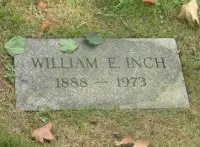

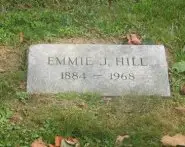
Graves of Willie Inch and Emmie Hill
Courtesy of Michael Poirier / Jim Kalafus
Richard Hill passed away in 1938 with his wife surviving until January 1968. Willie died in June 1973. The three were buried together in Kensico Cemetery in Valhalla, New York. Several Titanic survivors, including Elizabeth Nye Darby and Norman Chambers are buried in the same cemetery. Sylvia Inch moved to Briarcliff Manor, New York dying there in January 2001.
NOTES AND CORRECTIONS FOR Lest We Forget PART 1
After Lest We Forget Part 1 came out, we received some greatly appreciated additional information and corrections from our readers, and fielded a few questions raised by, but not answered in, our text. Through the magic of computer technology it would have been a simple matter to correct the online text and watch our mistakes vanish into the cyber void, and though we were sorely tempted to do just that we opted for the more intellectually honest approach of an appendix to Part 2.
SMITH / OWENS: The major error contained within, for which Jim has been suitably punished, was the declaration that Cecelia Owens never returned to the United States after losing both of her sons in the disaster. We soon learned from the Smith family and relatives of Hubert Owens that Cecelia was escorted back to the United States, and Ellwood City, Pennsylvania, by her husband, Hubert, in 1916. They remained in Western Pennsylvania, and in the Cleveland Ohio, area until the onset of the depression when they realized that their life savings would “go further’ in the United Kingdom. At that point they returned to Wales. We also learned, from anecdotal sources close to the Owens family that their older son had not wanted to make the fatal voyage. He wished to remain behind with his father, but in the end was compelled to go. Helen Smith, as it developed, went through a period of ill health in the early 1930s, which postponed but did not cancel her wedding plans. She worked in a shoe salon before her wedding, and kept in occasional touch with family in the United States. Her family also supplied the detail that Helen’s paternal grandfather had died before the disaster, and the “Grandparents” with whom she was placed were, in fact, her aunt and uncle.
HOW MANY SURVIVORS WERE LOST IN THE WAR?
The Pells, Gardner, and Wallace stories caused a number of readers to ask how many of the Lusitania’s men were lost to other acts of war. Here is the list that has so far assembled by Paul Latimer and others:
1916 August 12th Marichal, Mr. Joseph Phillibert Rene (II) 39 Hemwood, France KIA
1917 January 4th Finucane, Private Noel (crew) 26 KIA
1917 March 27th Nixon, Mr. Harold (crew) 40 lost on SS Thracia
1917 April 2nd Wordsworth, 2nd Lieutenant Osmund Bartle (II) 29 KIA Calais, France
1917 April 2nd Hebden, Private Robert (III) 37 Calais, France KIA
1917 August 21st Rossiter, Mr. Laurence (crew) 33 Lost on SS Oslo out of Hull
1917 October 15th Gardner, Lance Corporal Eric Clarence (II) 21 KIA
1917 October 31st Duguid, Private George Davie (II) KIA
1918 February 2nd Jones, Captain Arthur Rowland (crew) 38 Lost on HMT Avanti
1918 May 27th Pells, 2nd Lieutenant Cyril Elmore (II) 27 KIA
1918 August 7th Mosley, Major George Gordon (I) 33 Died of illness in India
1918 September 9th Wallace, Lieutenant Cyril John George (II) 22 KIA
1918 November 7th Griffiths, Lieutenant Christopher William (II) 35 died of wounds received Oct 29th
1918 November 24th Foden, Private Robert Ernest (crew) 29 KIA
To this list may be added Matthew Backa, of Saskatchewan, who was returning to Russia. After his arrival, he was never heard from again. He may have been lost in the war, the revolution, or in the famine of the early 1920s.
WITHERBEE; No first person account of Beatrice’s experiences has surfaced since we wrote part 1, but researcher Peter Kelly was able to send us a description of what Alfred Scott Witherbee Jr. was wearing when his body was found adrift off Kinsale. A month after his death his face was unrecognizable, and it was by his clothing that he was identified:
Blue shirt
Blue flannelette trousers
Brown button boots
Round sailor's cap
Ribbon marked "New York" between two flags
Grey plaid coat
This identification was, at best, tentative and certain details of the body do not match the known details of A.S. Witherbee’s appearance. For instance, the body had dark hair while the Witherbee child was fair. Charlotte Luck’s widower believed that remains were those of one of his sons, but ultimately the Witherbee family won out and the body was buried as Alfred Junior. Unidentified body #185, another young boy, was recovered in a similar outfit and one wonders if, perhaps, he might be either the Witherbee or Luck child.
WHY Lest We Forget?
We chose that title, in part, because the phrase Lest We Forget was used so frequently in the 1915 coverage and had period appeal. However, out principal reason was because survivor Rita Jolivet made a blockbuster of a Lusitania movie, semi-autobiographical, by that title. It was filmed aboard an impounded German liner (Martha Washington) in New York harbor, utilized a hugely expensive model of the Lusitania for exteriors, featured a sinking sequence with hundreds of extras floundering in the Hudson River and, as a climax of sorts, depicted Rita strangling her evil German admirer with a cord. Filmed in 1917, and released to excellent reviews in 1918, it had a commercial life of over two years. Rita promoted it tirelessly -she was both the star and the producer.
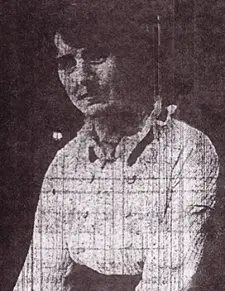 |
AMORY: Too late to include in part 1, we learned what became of Phoebe Amory’s cabin mate, the beautiful Mary Higginbottom (sometimes listed as Higginbotham). According to survivor Duncan Hanes:
a young lady with whom I was acquainted and whose name was Miss Higginbotham (sic) came over and urged me to join her party in a game of cards. It was while I was declining as politely as I could, this invitation, and while we were both standing on A deck very near the stern of the boat that we heard a sudden crash, and in a second debris was falling all around us…I escorted Miss Higginbotham to the point where the boats were about to be lowered. She entered one of the first ones, which owing to the momentum of the ship- it was going about 18 knots when struck- foundered as soon as it struck the water and she, with dozens of others, was drowned.
BEATTIE: We recently found a profile of Allan Beattie from the mid 1930s which implies that his Canadian Claims court appearance, (at which past employees were summoned to testify that post-traumatic stress had left Allan all but unemployable) marked a turning point in his life. He, apparently, invested his settlement money in a movie theater and, as of 1934, was prospering.
BRANDELL: Courtesy of Shelley Dziedzic came this new photo of Josephine, dating from 1906.
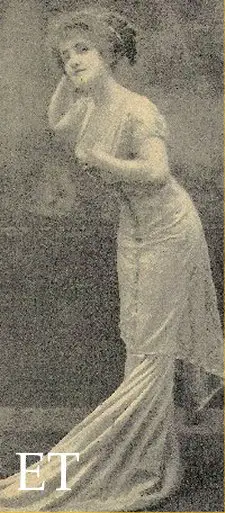 |
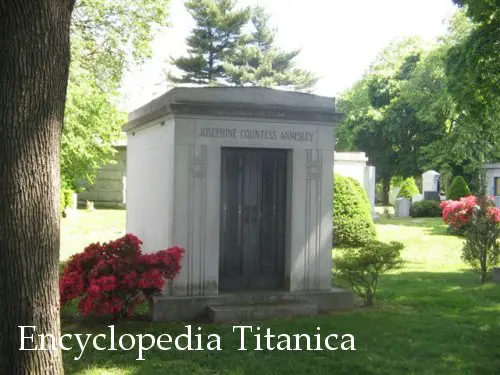 |
|
Josephine Brandell age 15
(Shelley Dziedzic) |
Josephine Brandell’s Grave at Woodlawn Cemetery, Bronx, NY
(Michael Poirier) |
BRETHERTON: Courtesy of Peter Kelly came this photo of the grave of Elizabeth Bretherton at the Ursuline Convent in Cork.
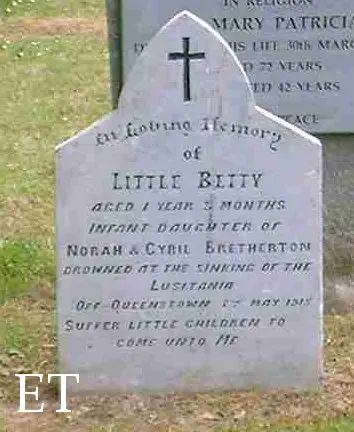
(Peter Kelly)
DEDICATIONS
We would, first of all, like to thank collectively, all of our readers who took the time to contact us or post to our various threads after part 1 came out. It was all appreciated more than we can ever hope to express adequately.
On behalf of both of us, Mike thanks Craig Stringer and Paul Latimer for their many genealogical contributions, the late Lawrence Jolivet, the late Paul Harrison, Mary Harrison, Dorothy Williams, Nancy Dorney, Steve Bedard, National Archives, Lusitania Collection MS45, the Lander family, Thomas Bilicke, Joe Carvalho, Michael Findlay, Shelley Dziedzic, Bob Bracken, Barbara Paterson, Nanette LaChance, Jack Eaton, Allen Jennings, James Wang, Malcolm Barres-Baker, Richard and Jane Woods (children of Nancy Wickings-Smith Woods) and Bob Florence of the Saskatoon Phoenix, who took the challenge of tracking down the fate of Francis Luker. And special thanks to Katherine Chancellor and Rosa Amici.
Jim, for his part, would like to thank Ray ‘Zoomer’ Roberts and Tim Yoder, two people with amazingly- sometimes frighteningly- eclectic powers of recall, with whom he never tires of speaking, and Peter Kelly who has been a good friend through all of this and who is always willing to help. And, as always, Alvar.
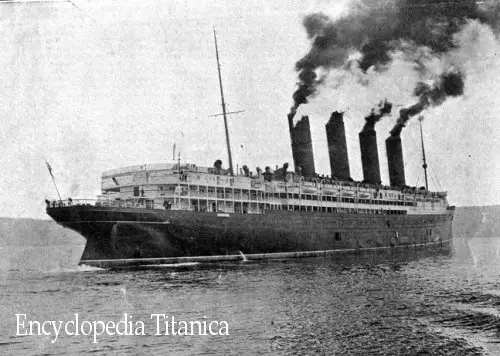
(Scientific American)
© 2005 Jim Kalafus and Mike Poirier

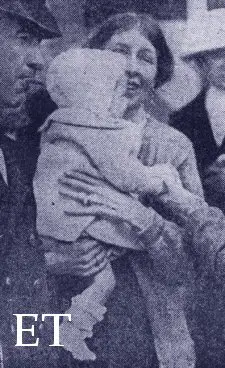
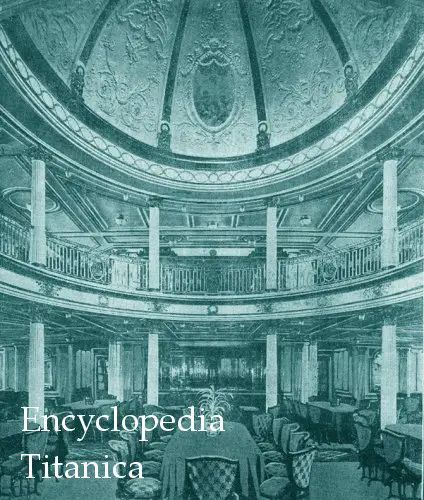
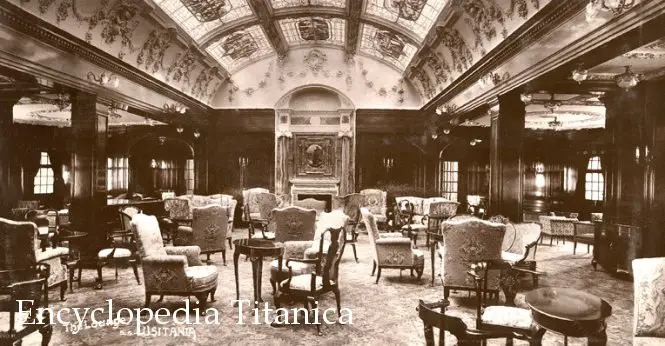
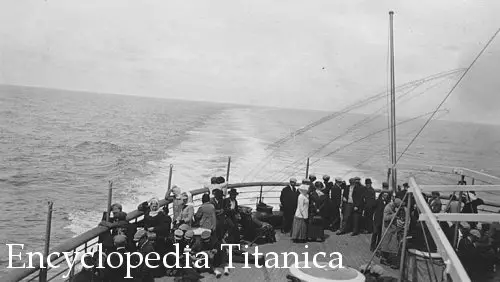

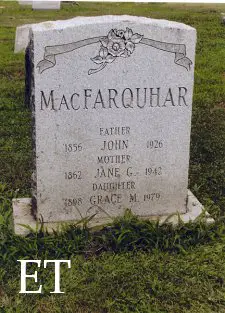
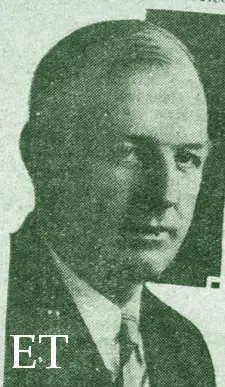
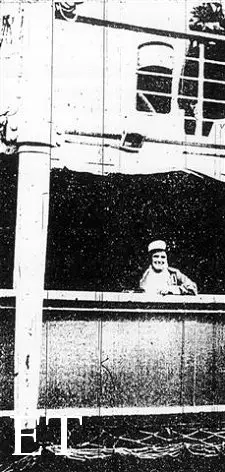
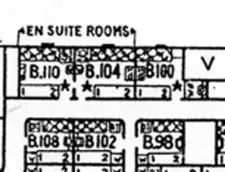
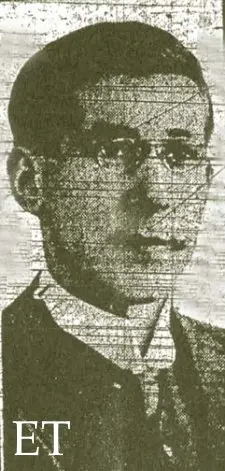
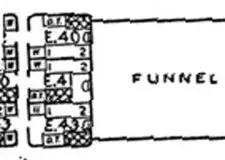


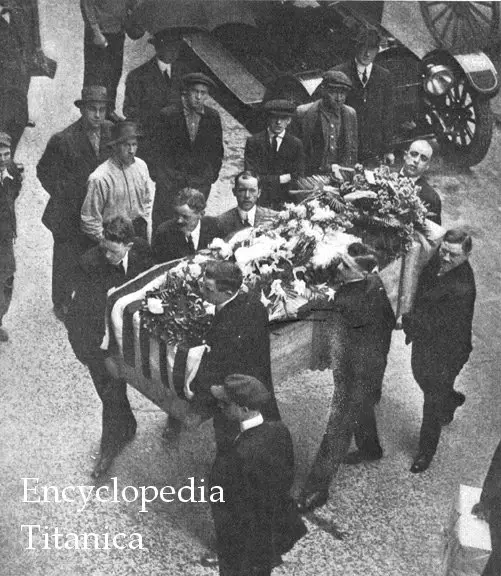
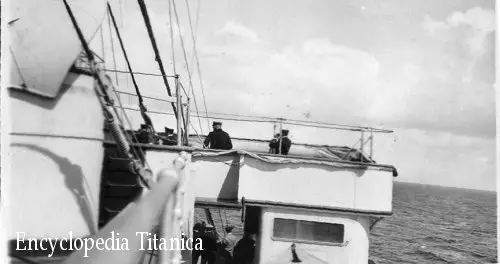
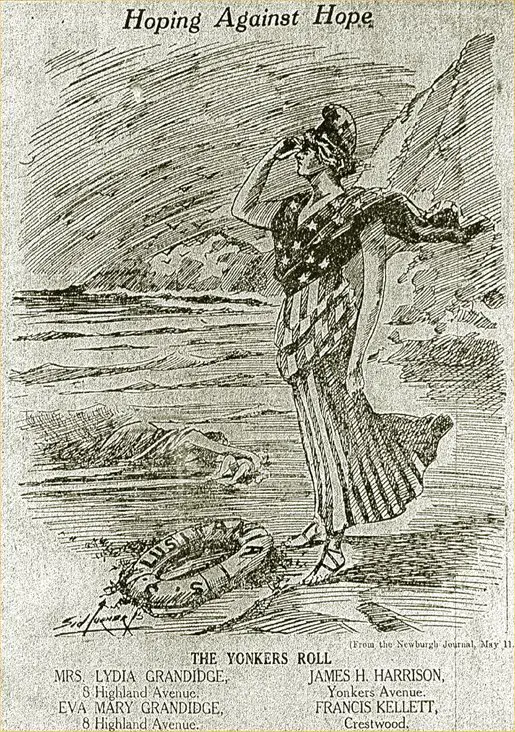
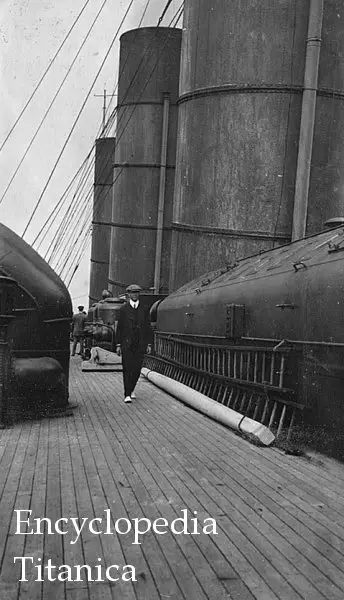

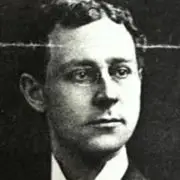
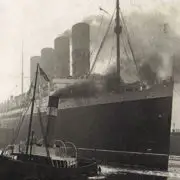
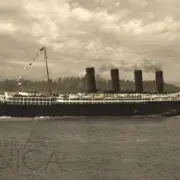
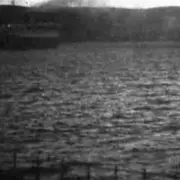
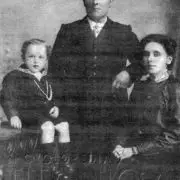 Mike Poirier
Mike Poirier
